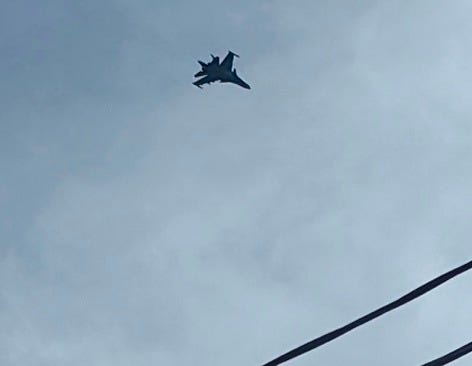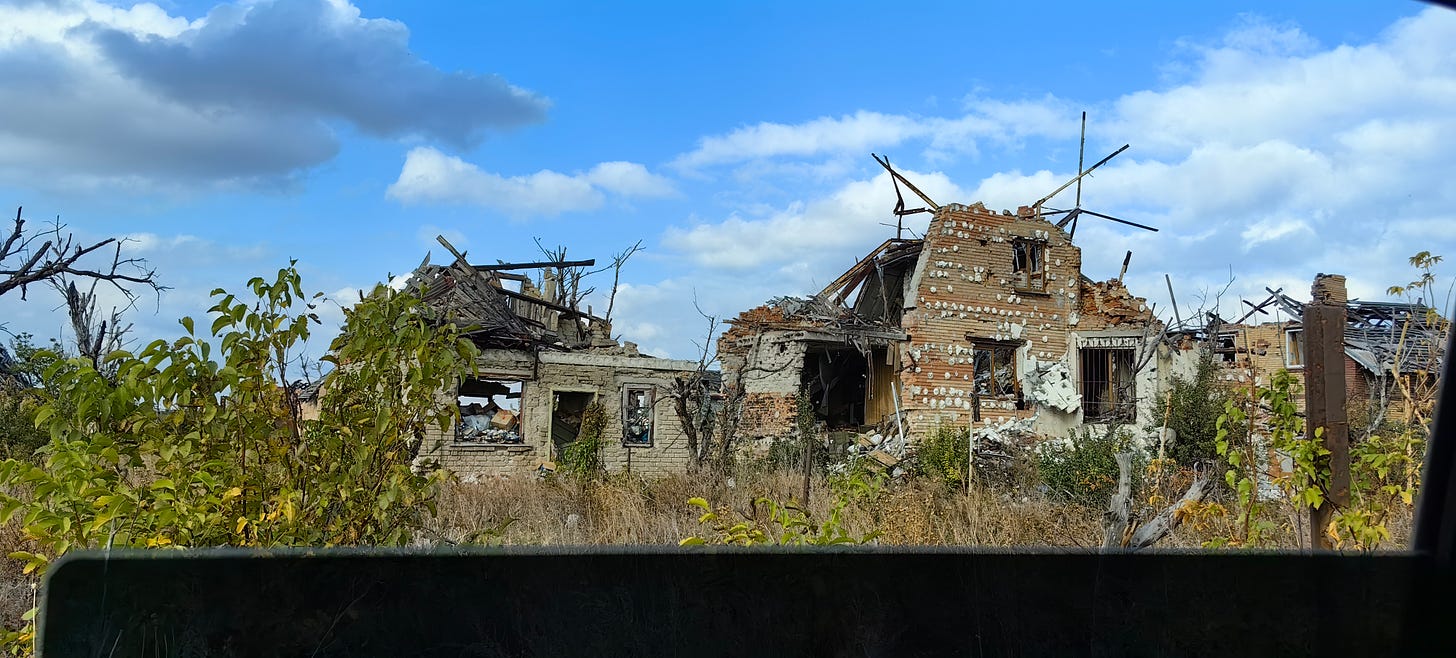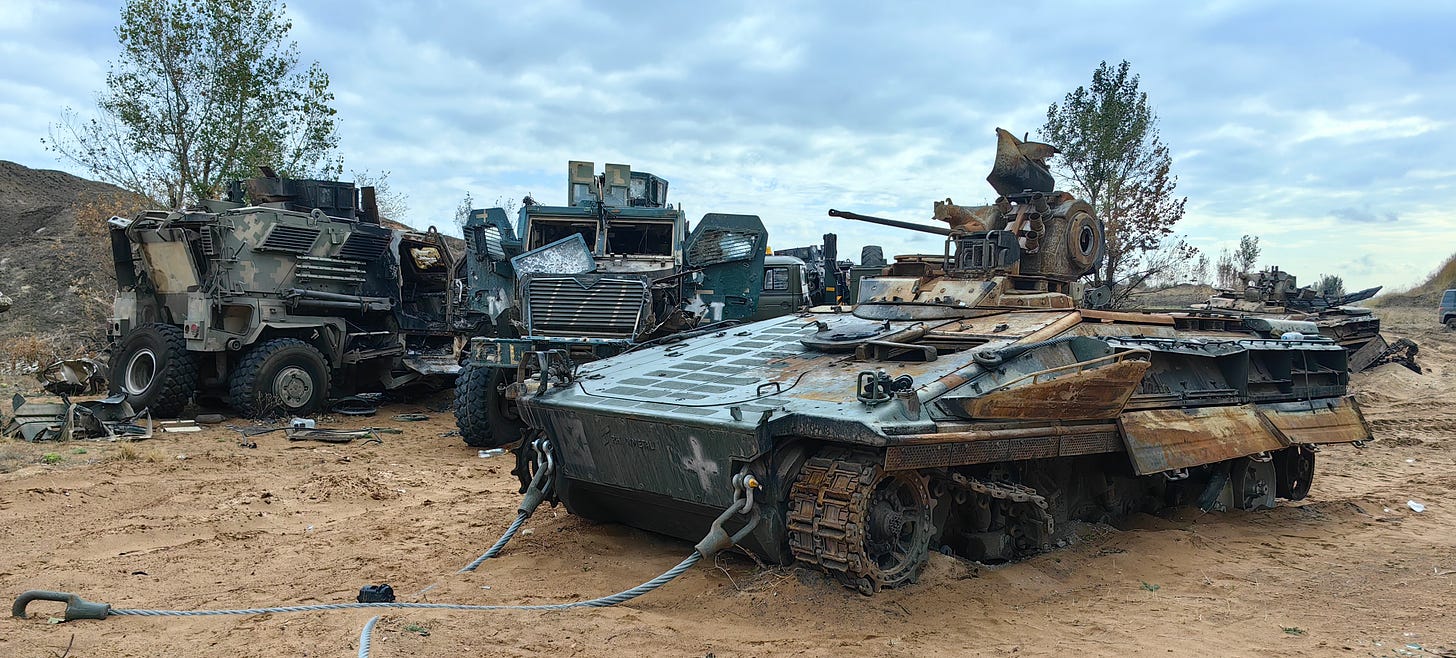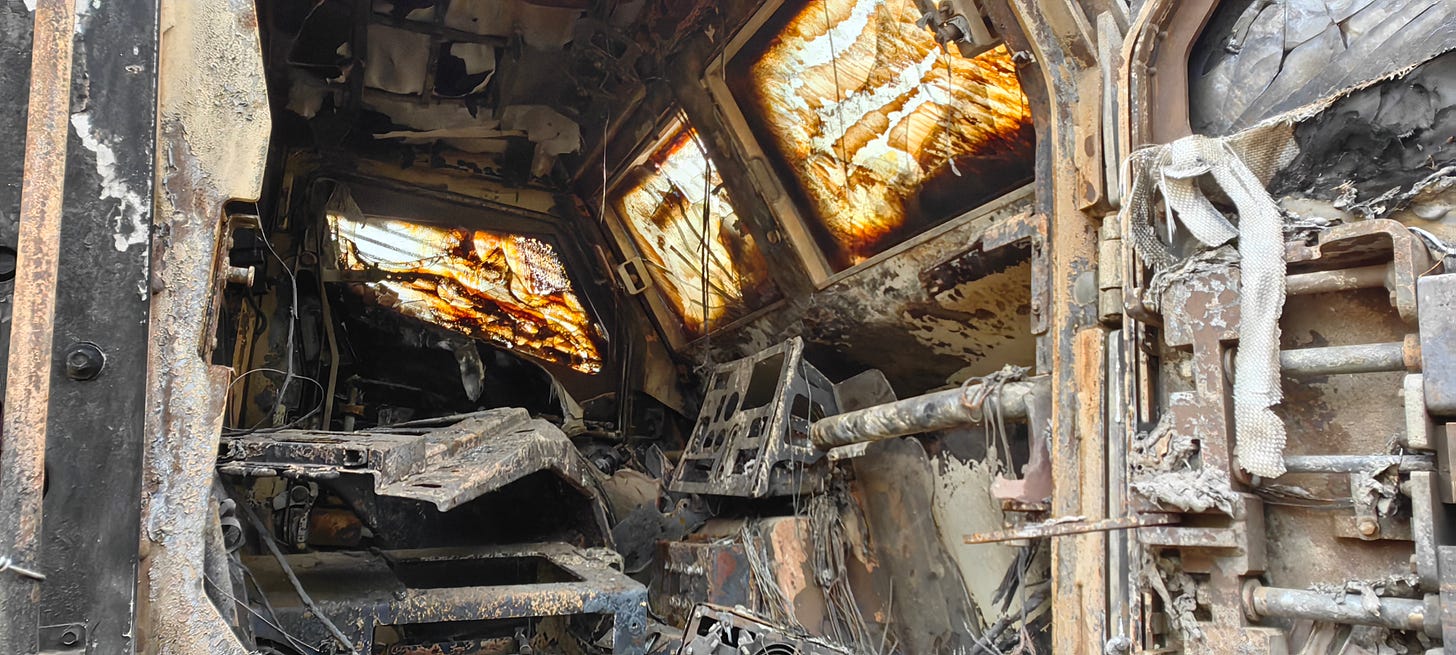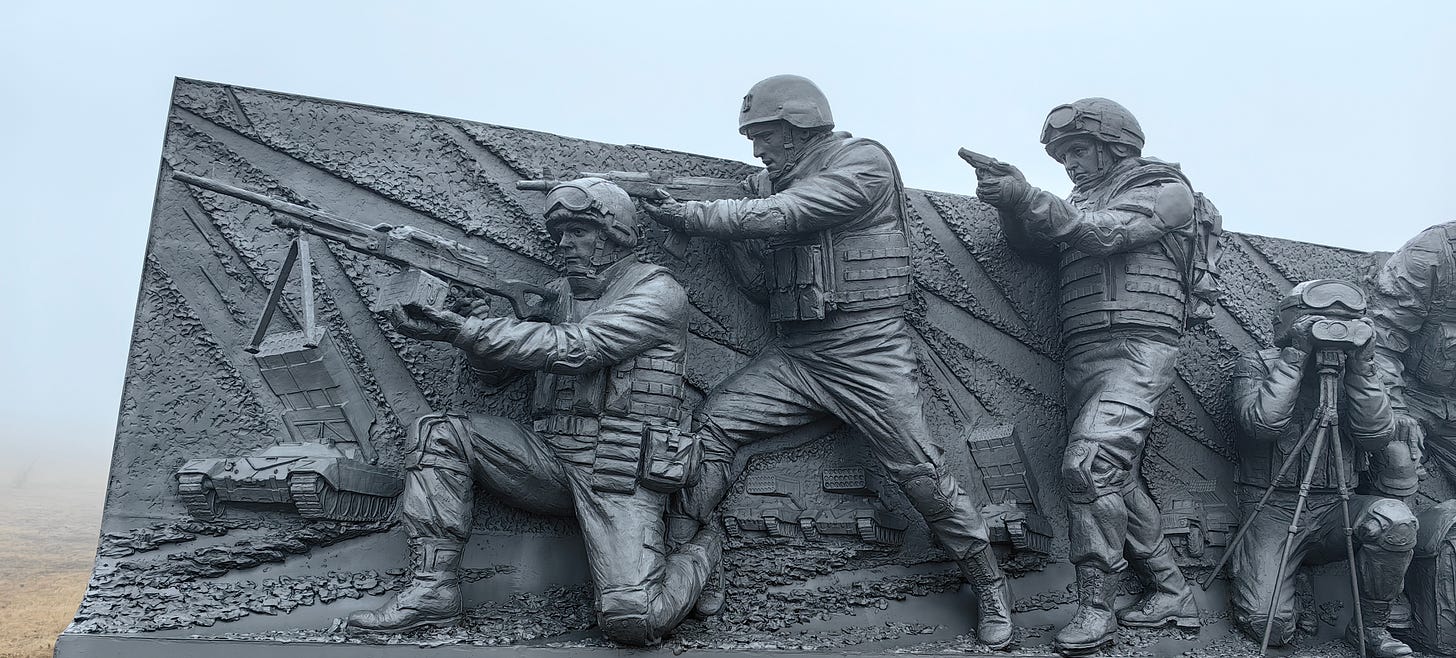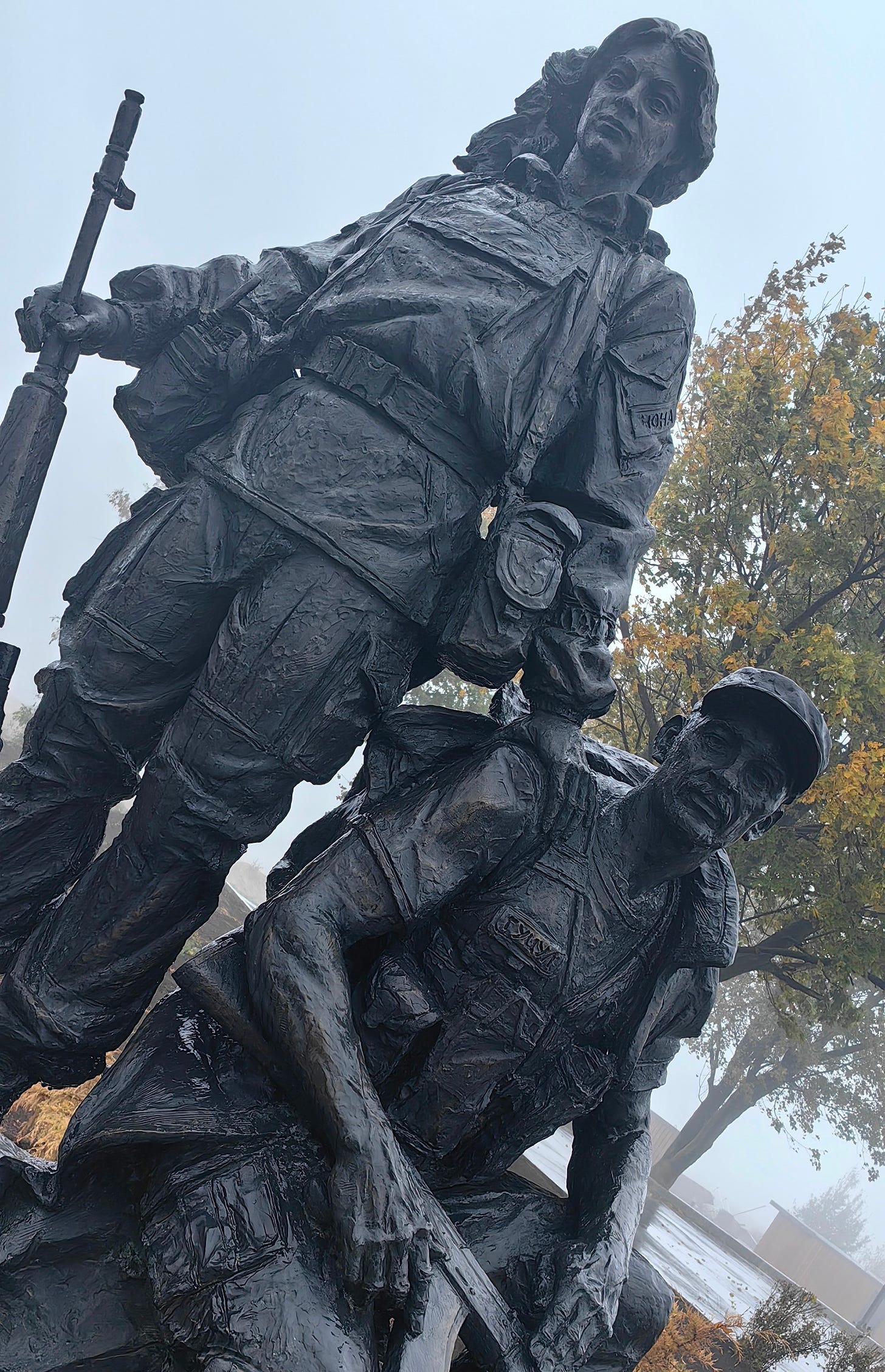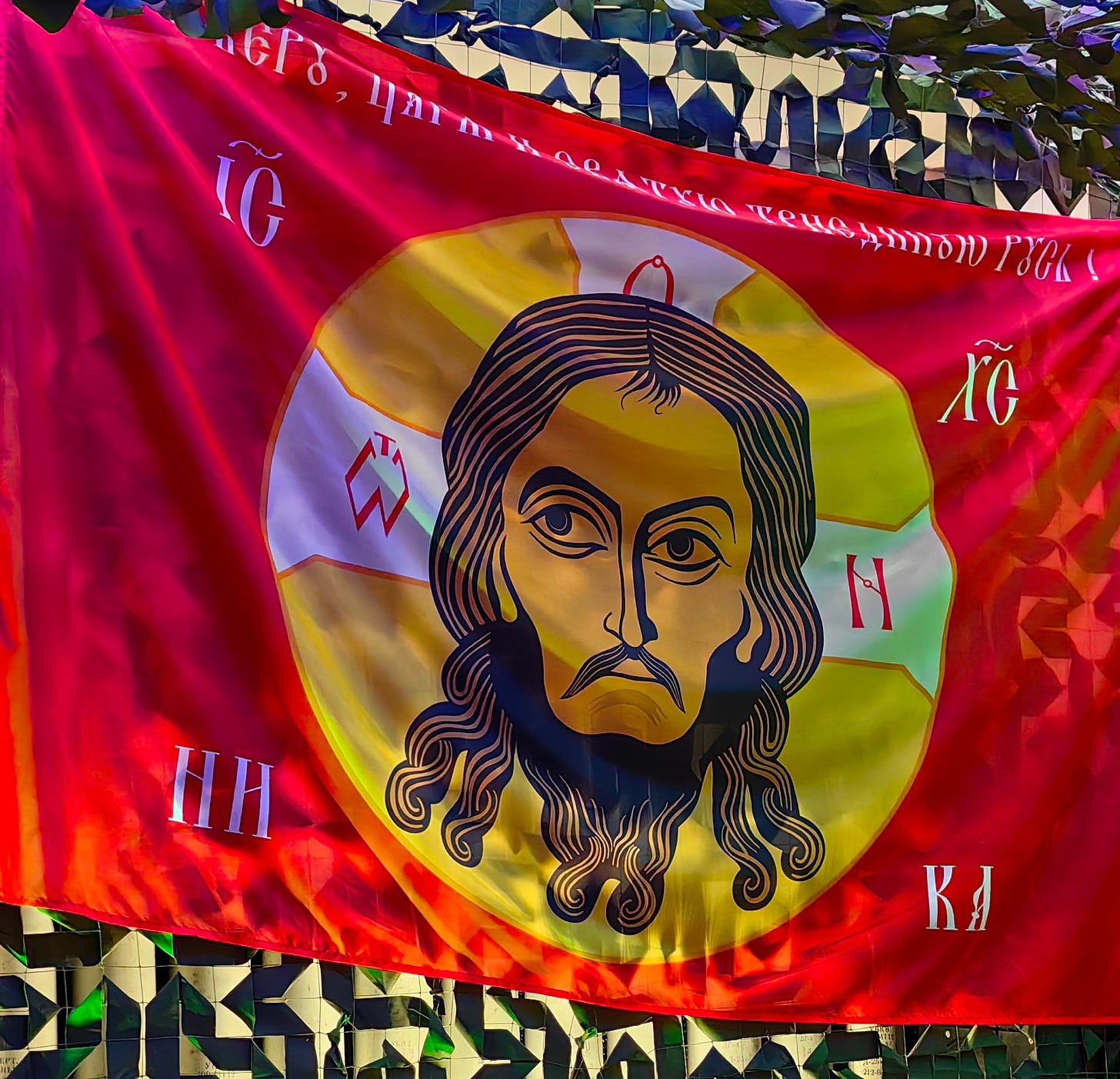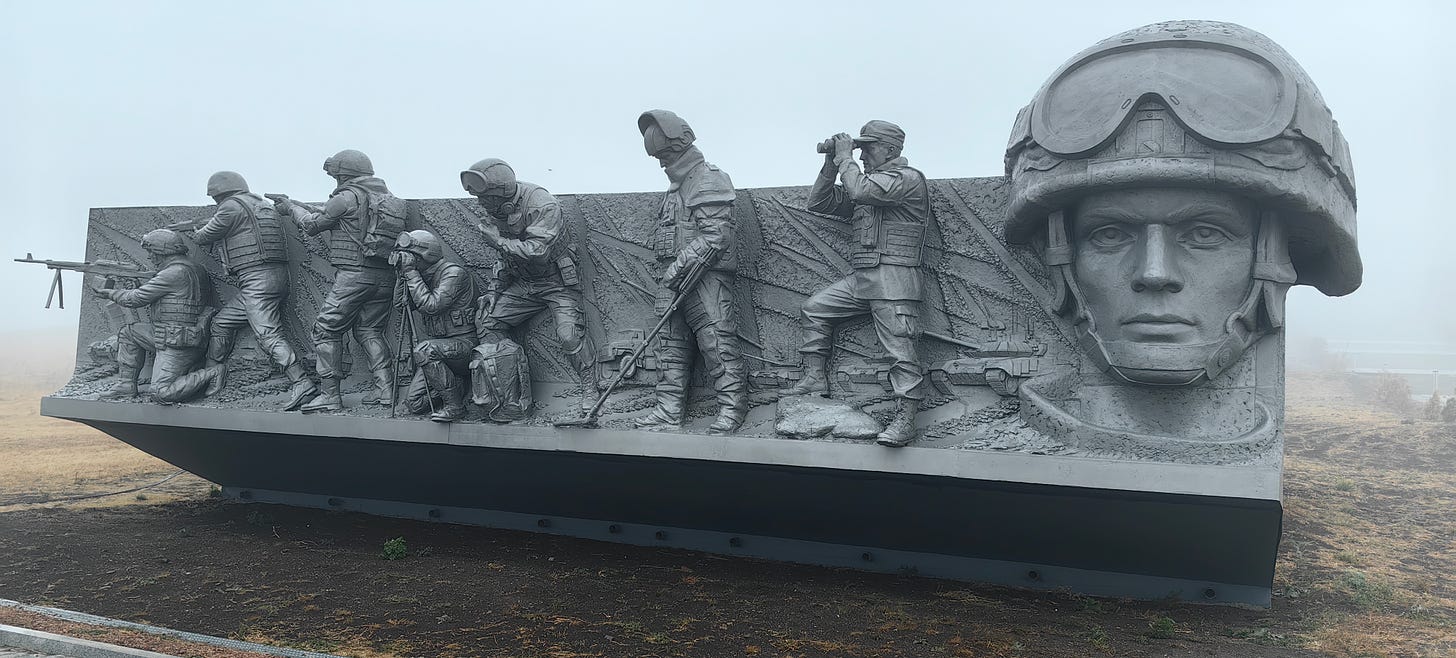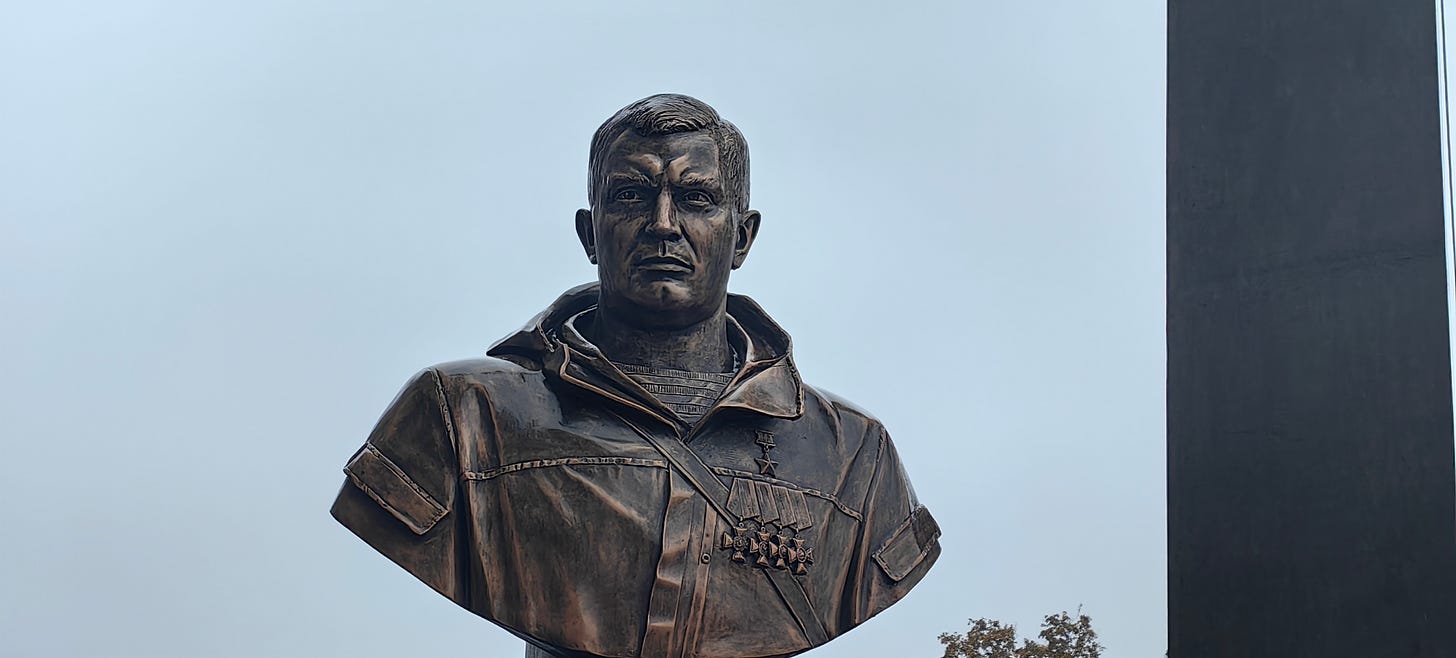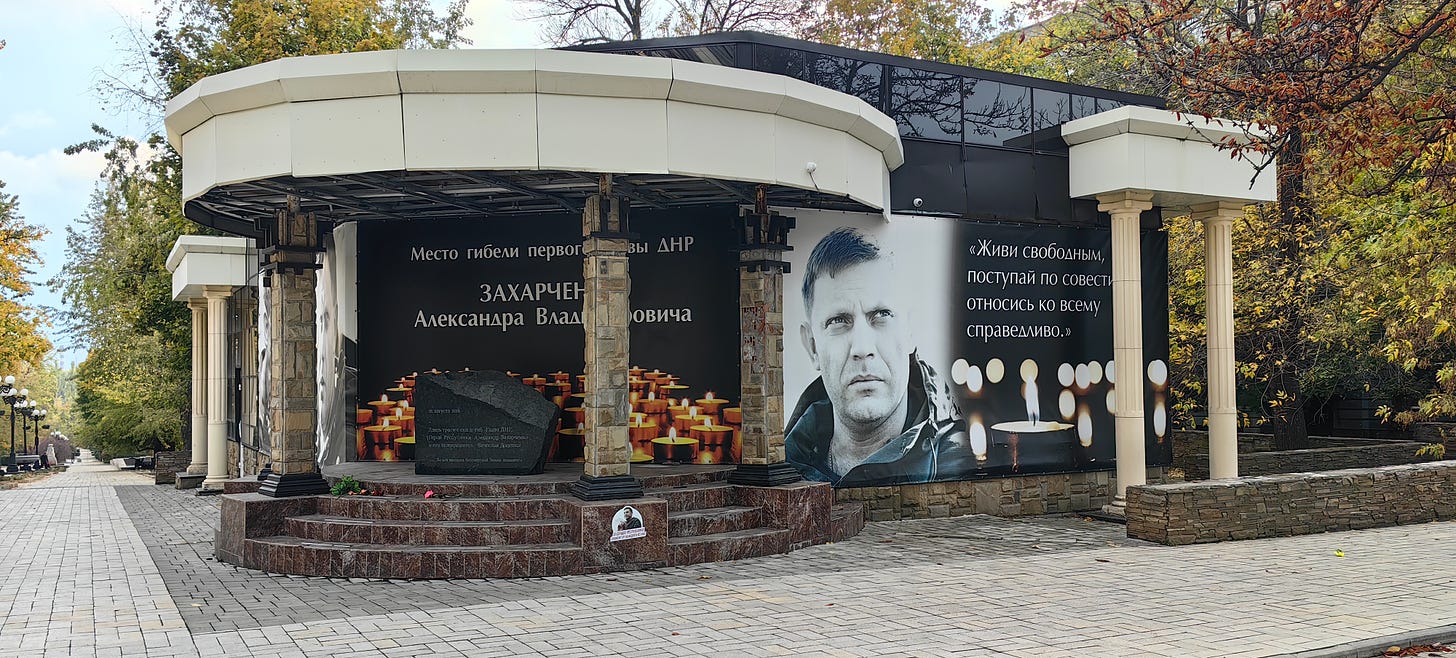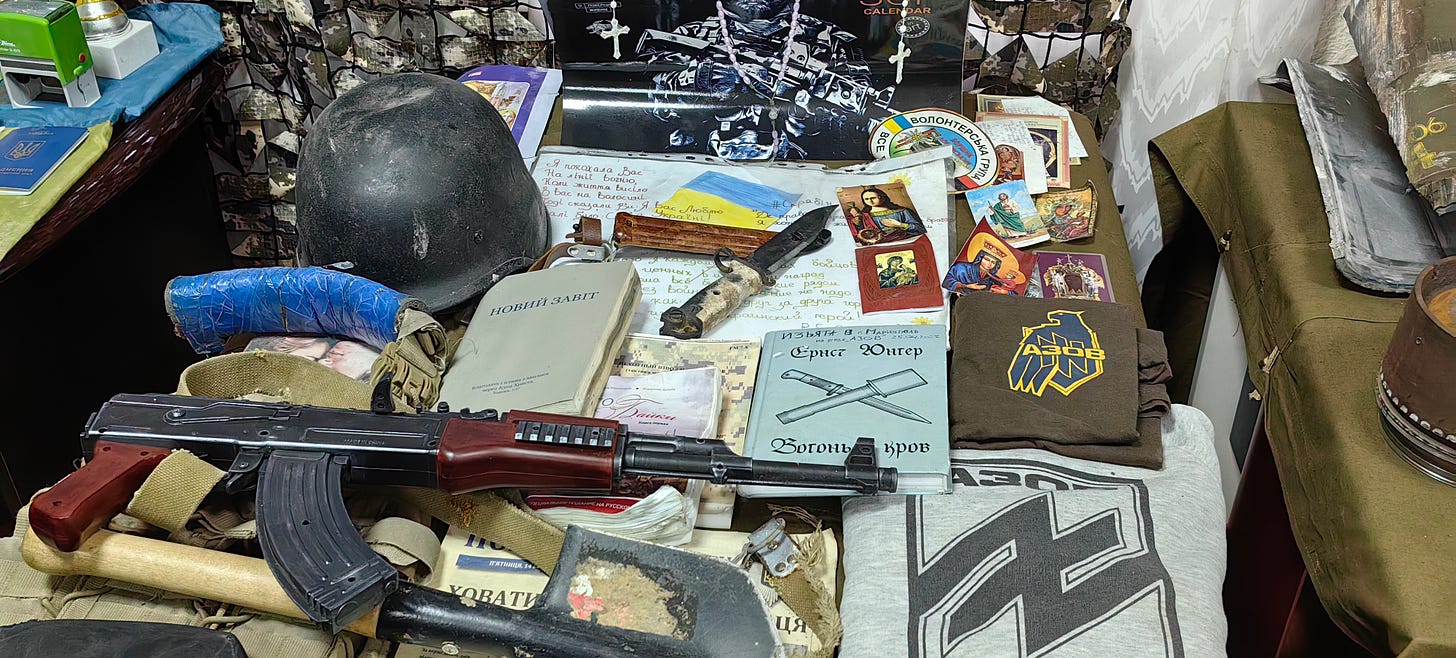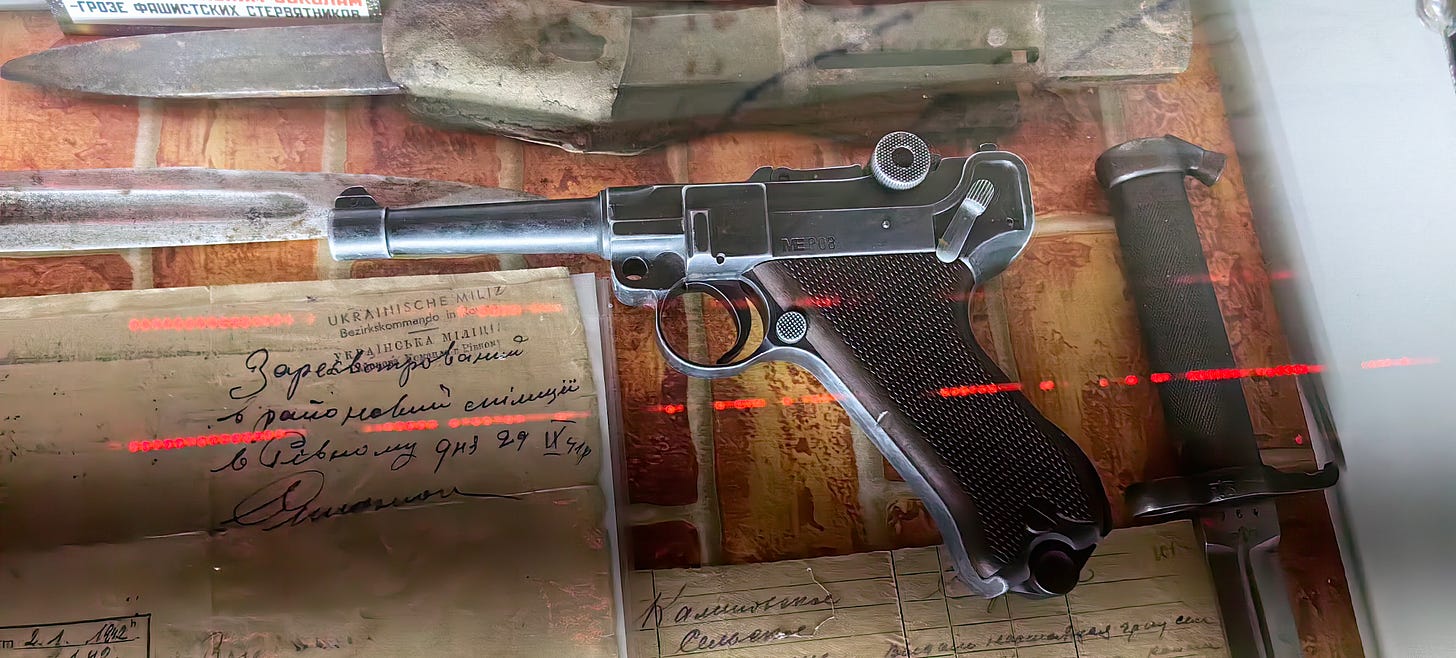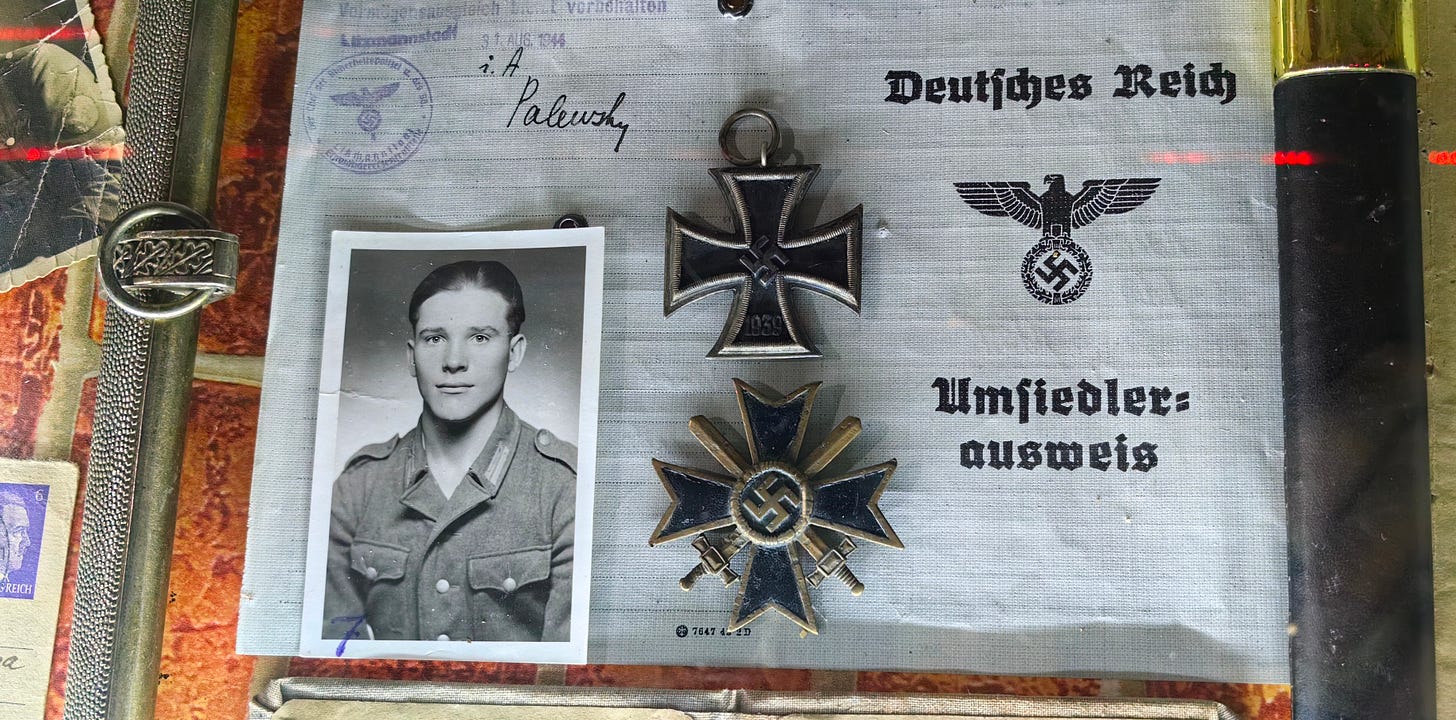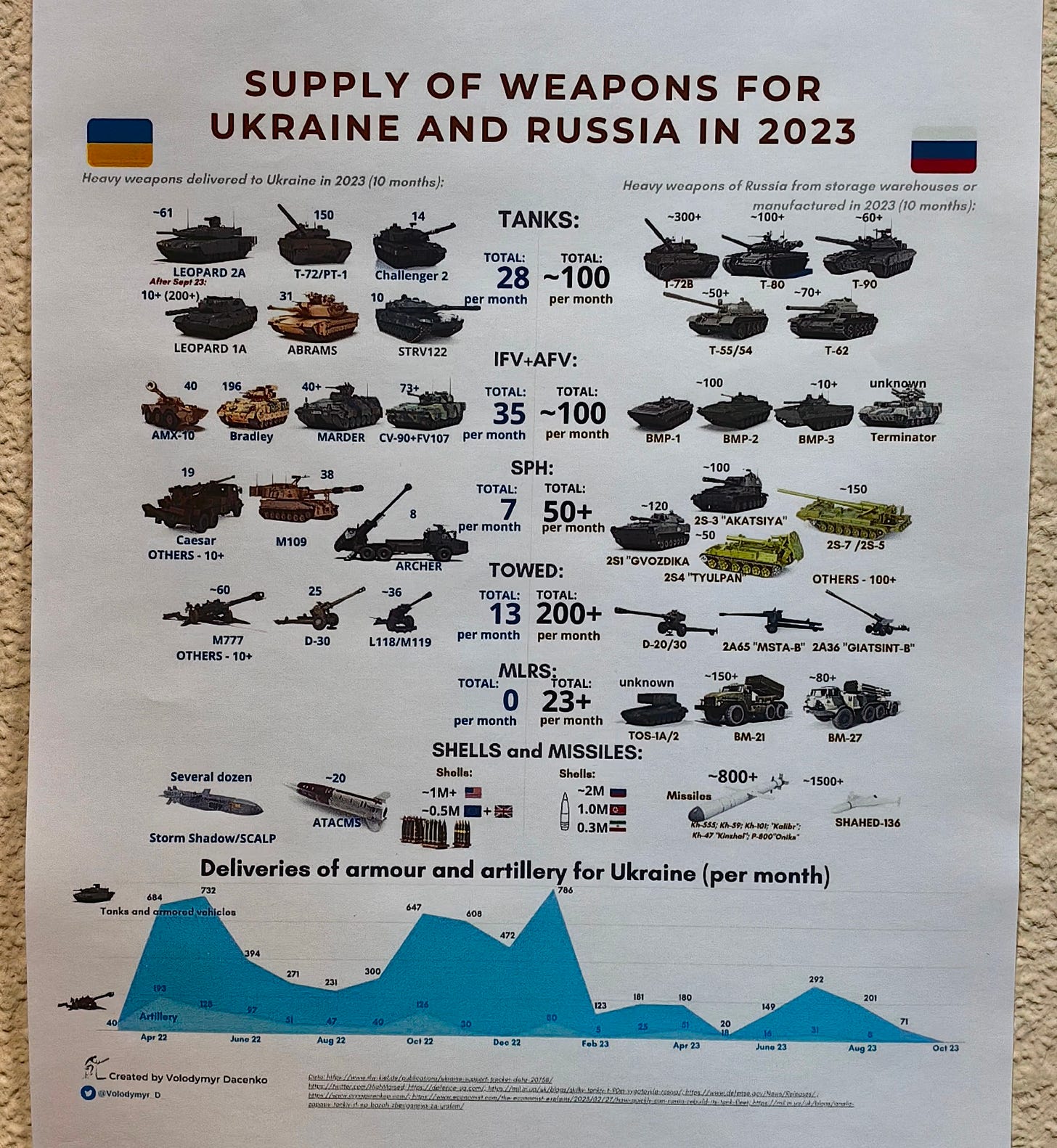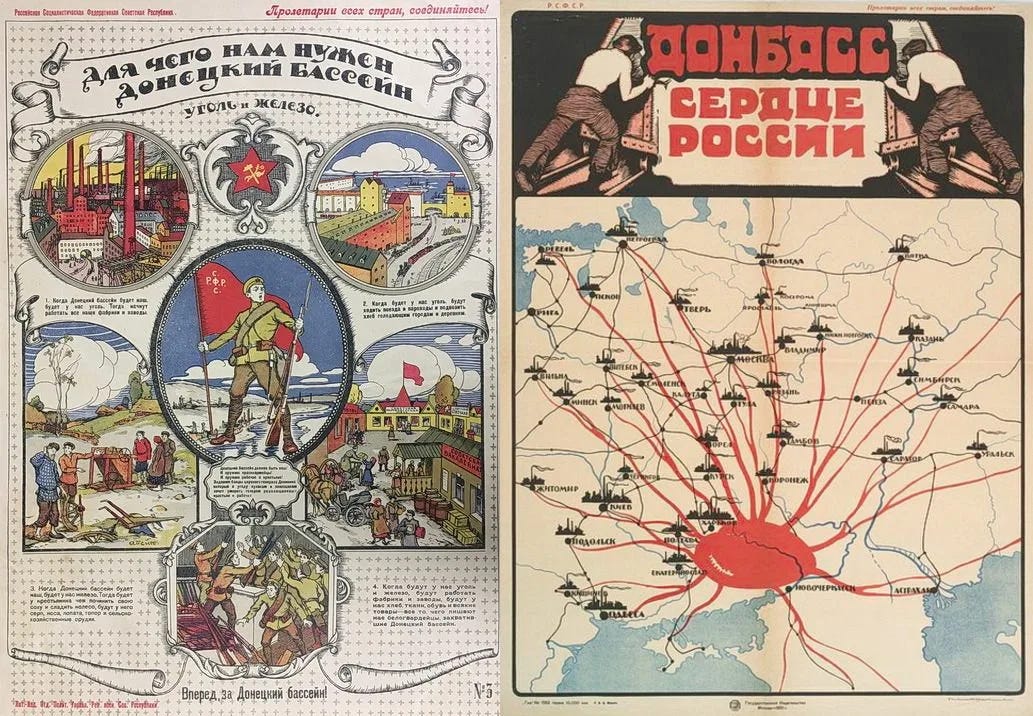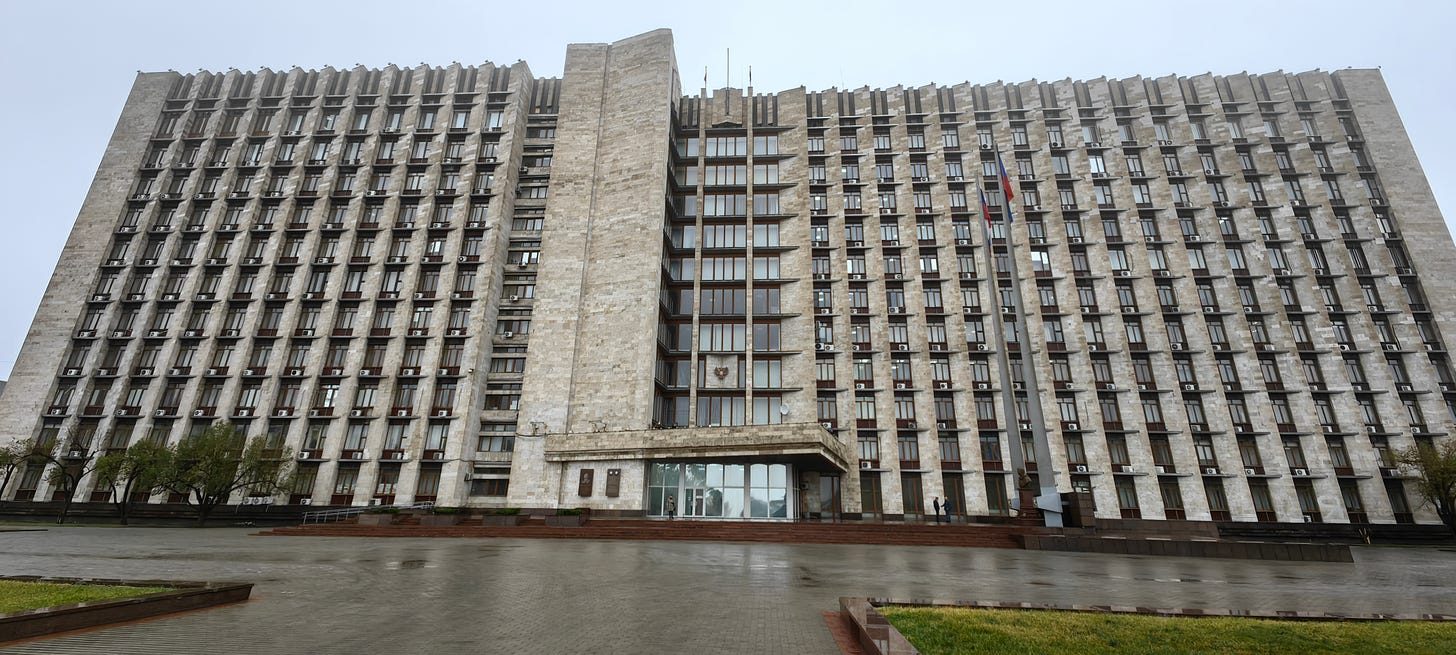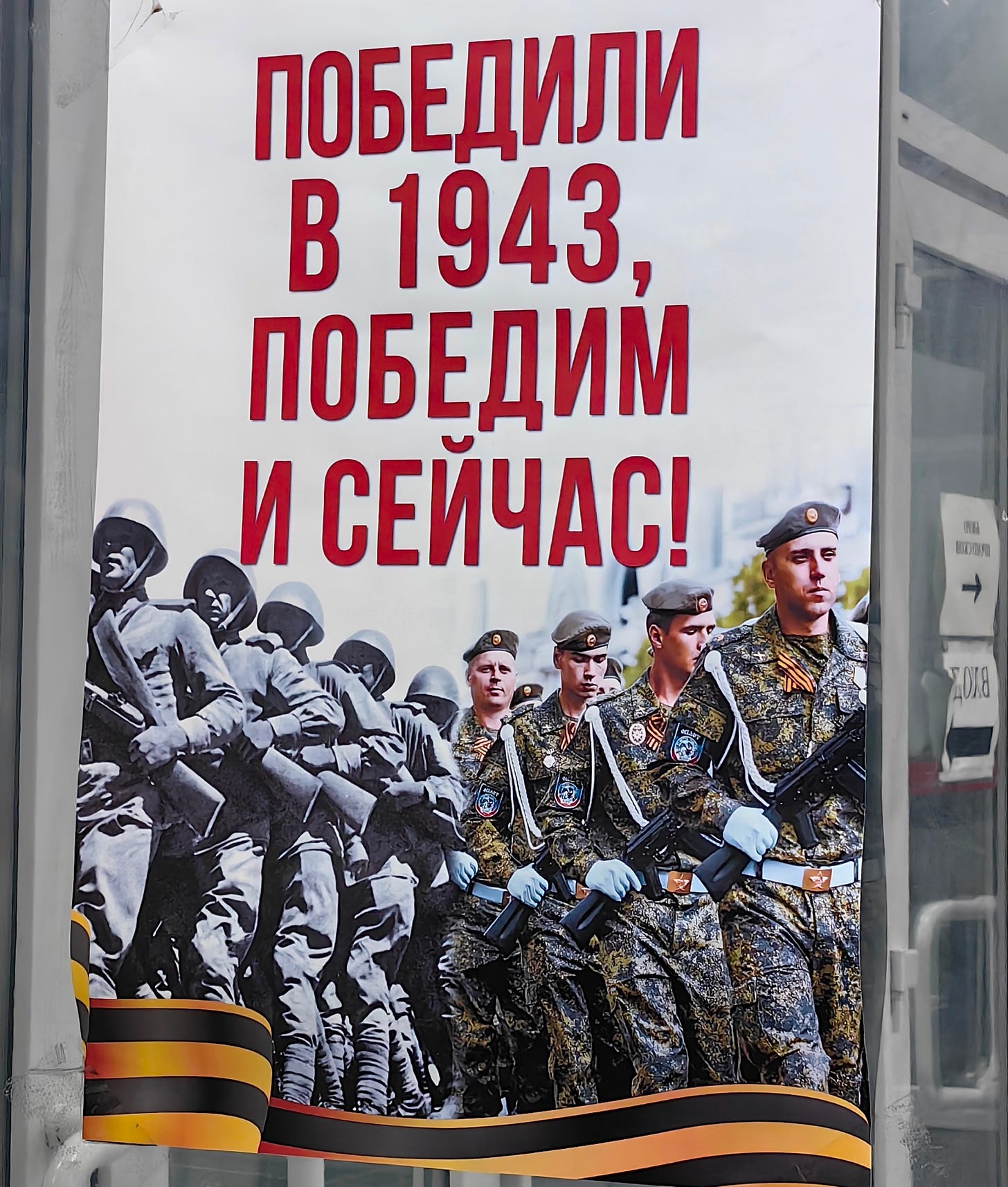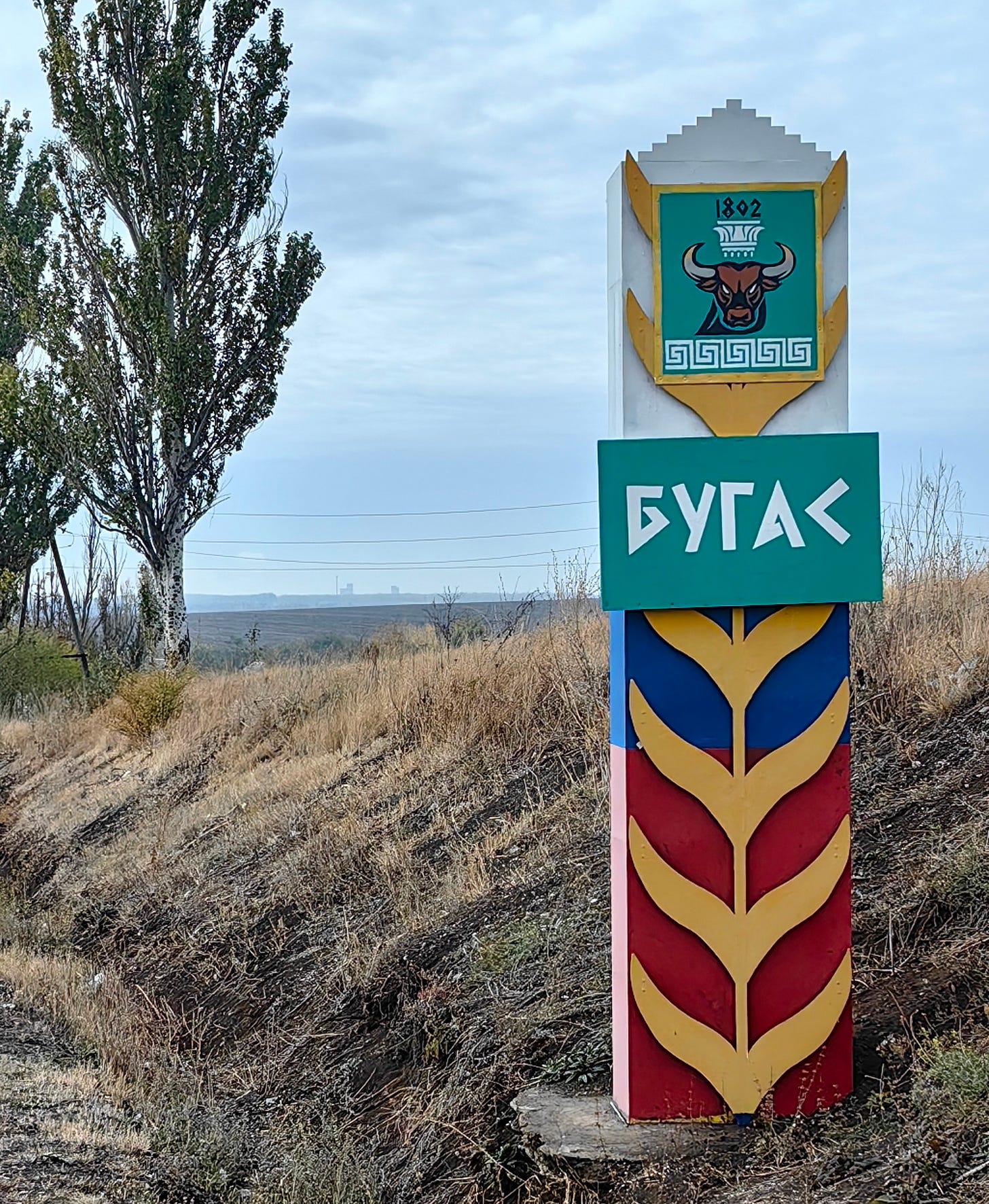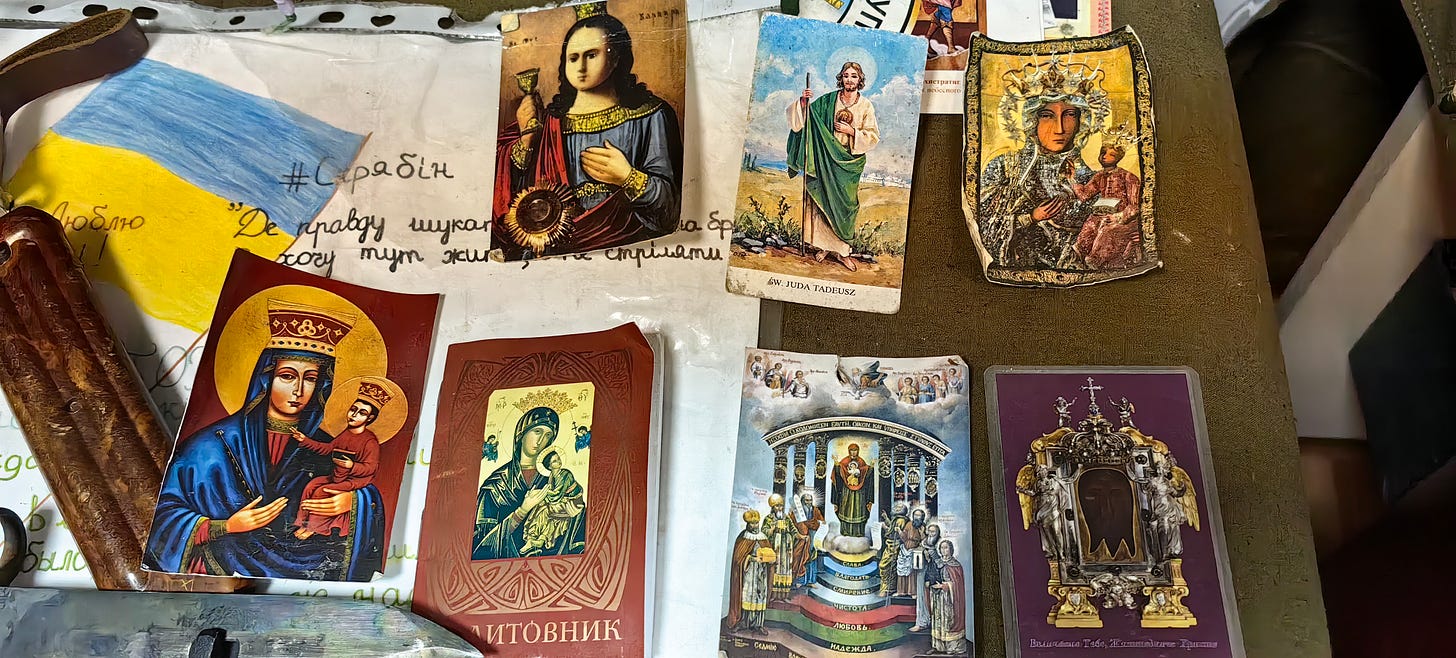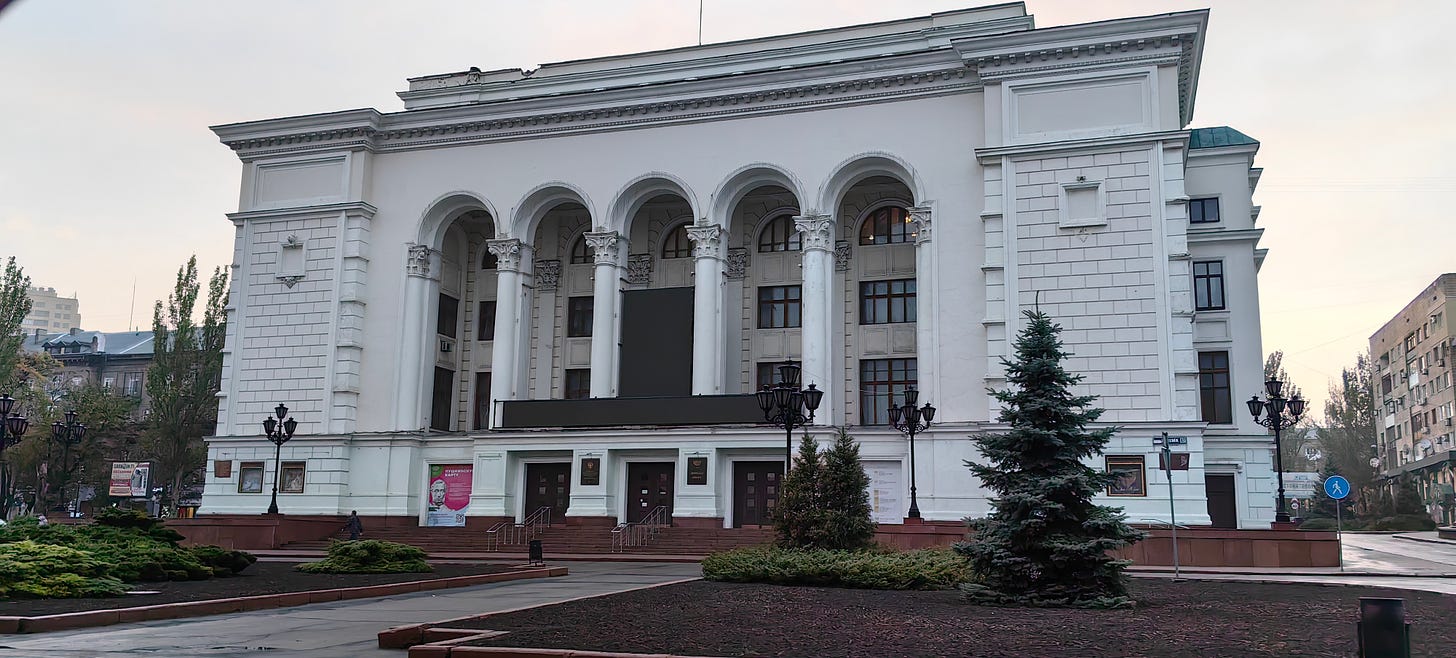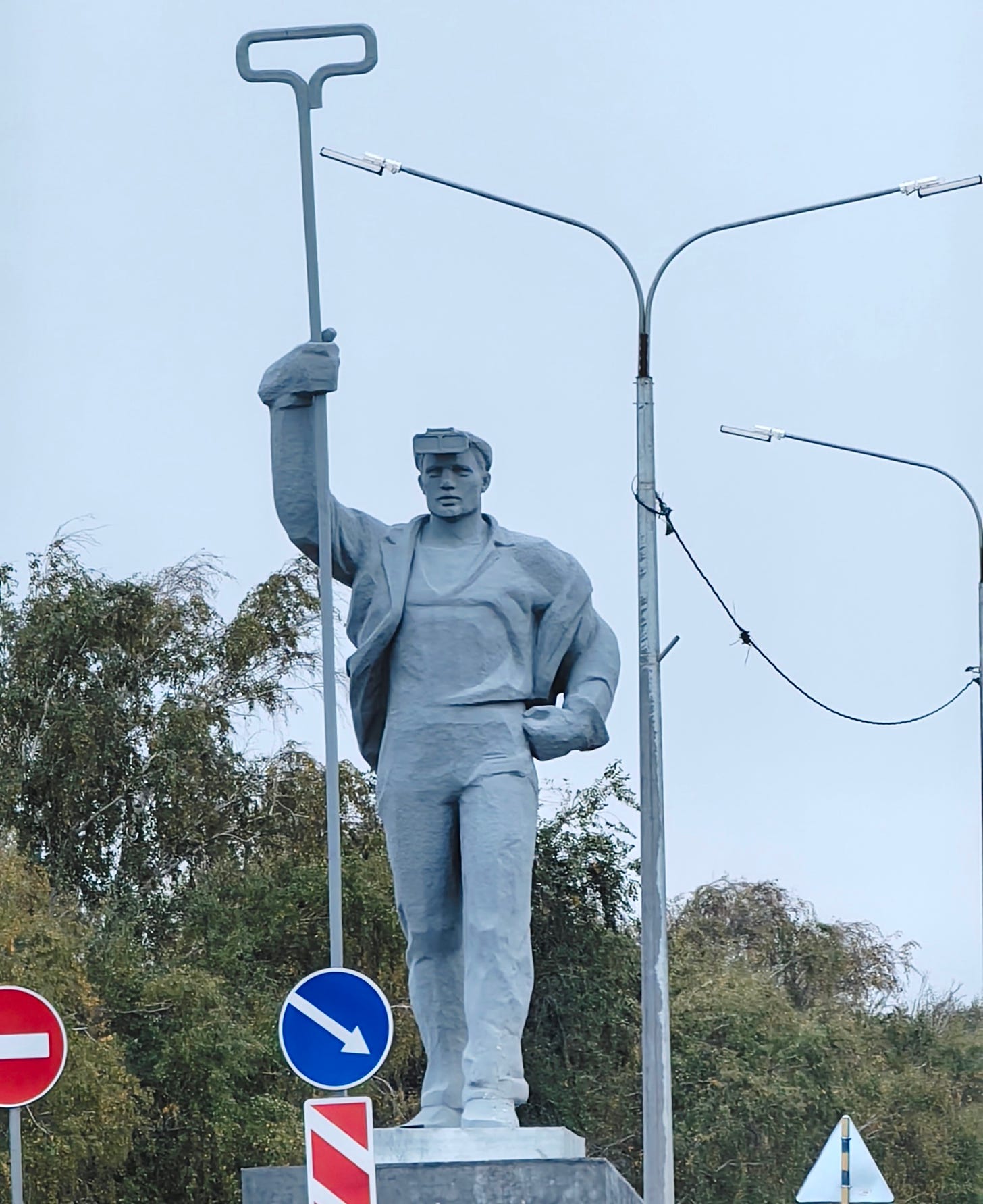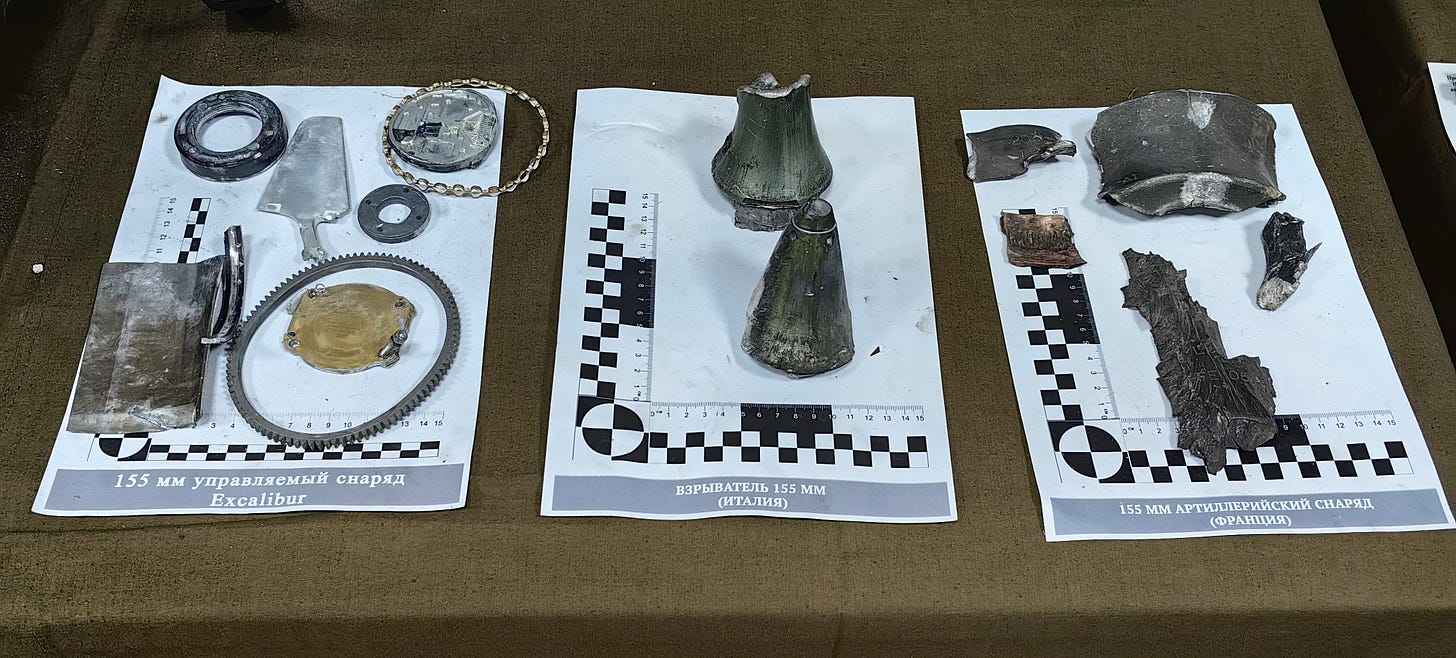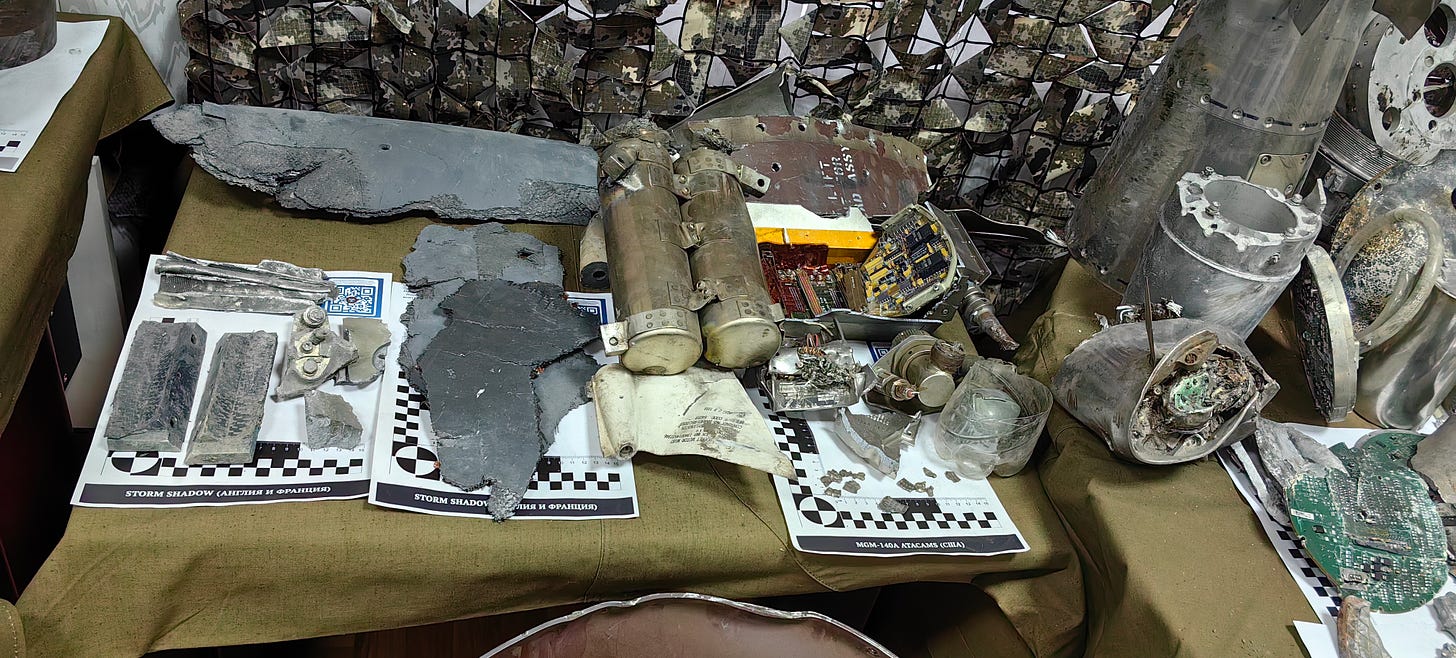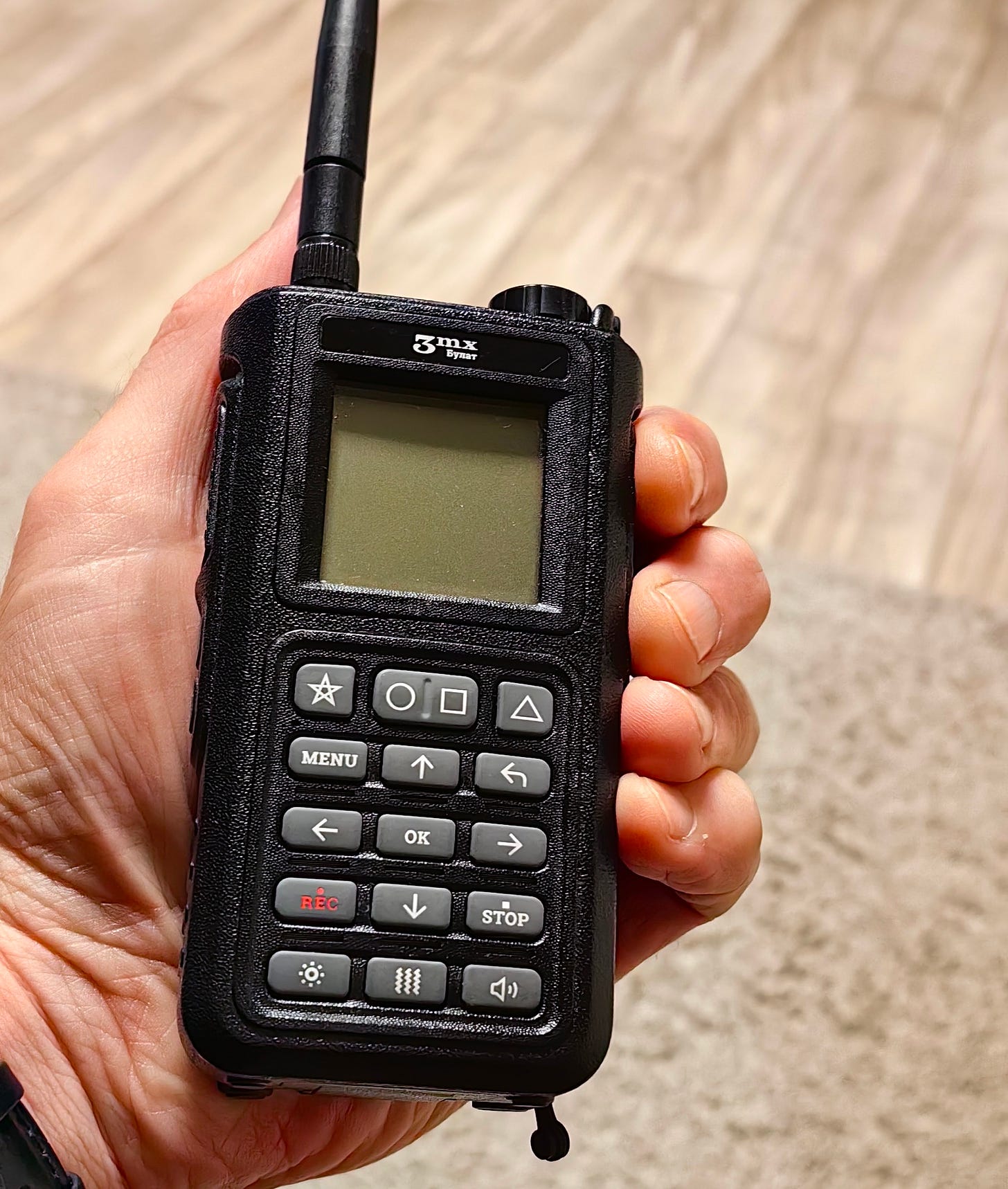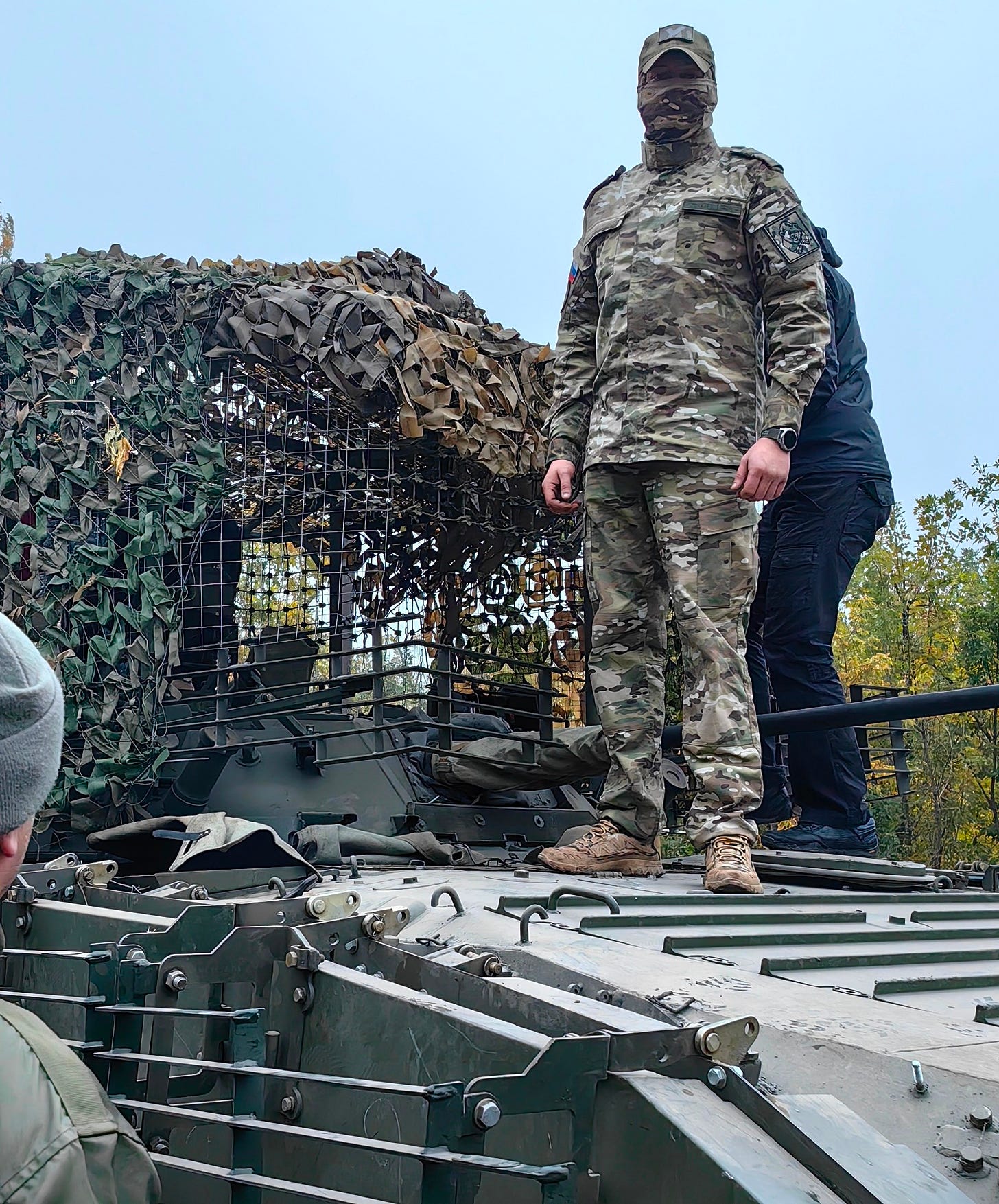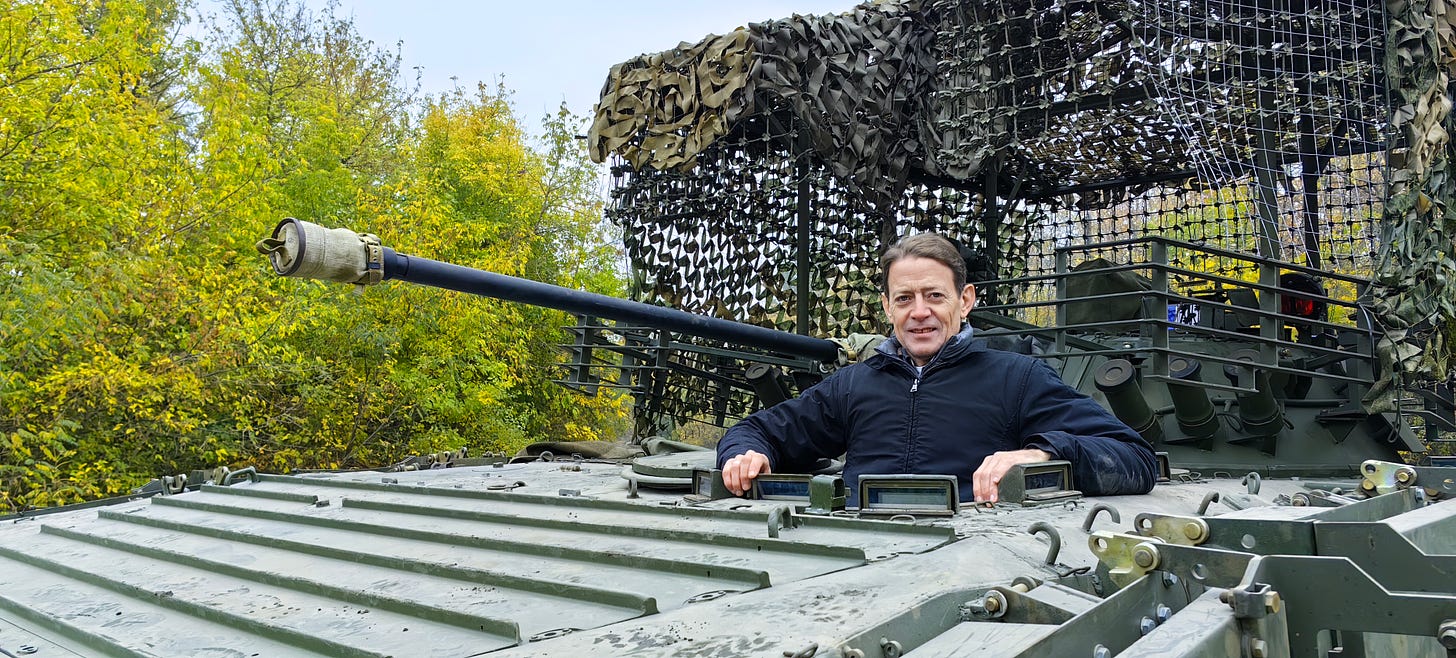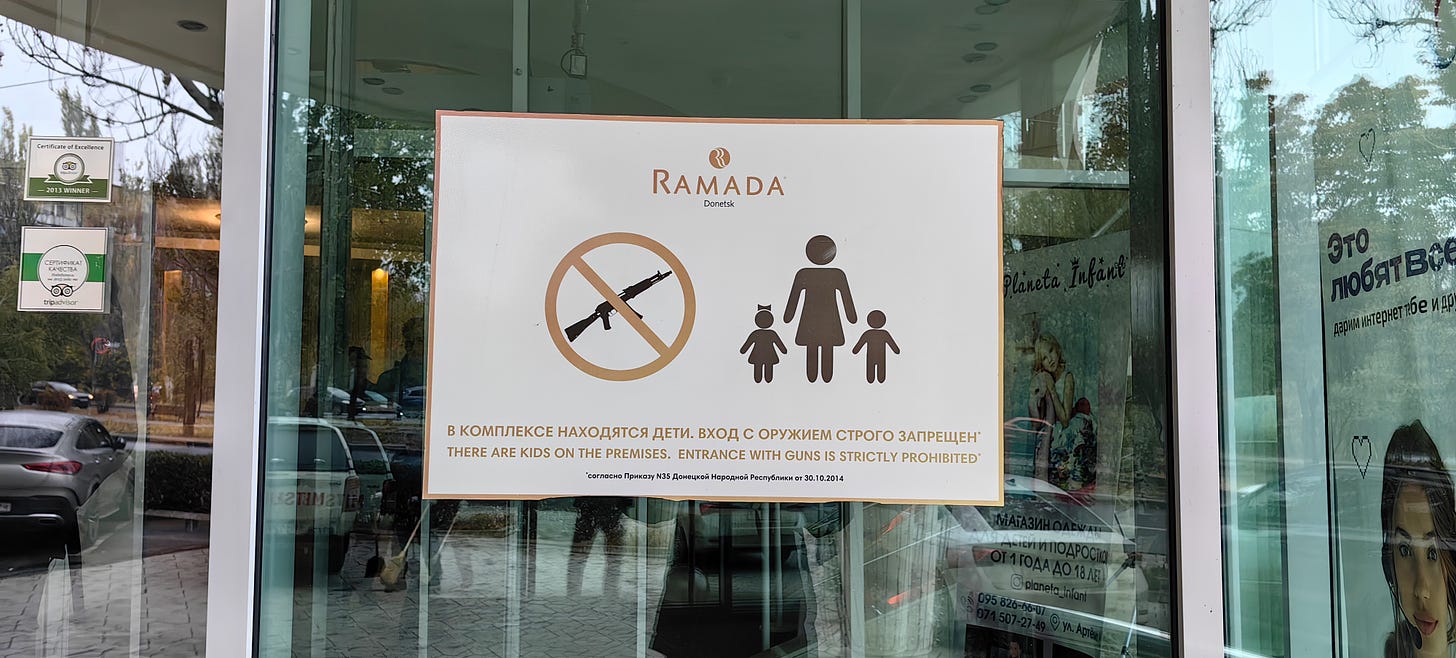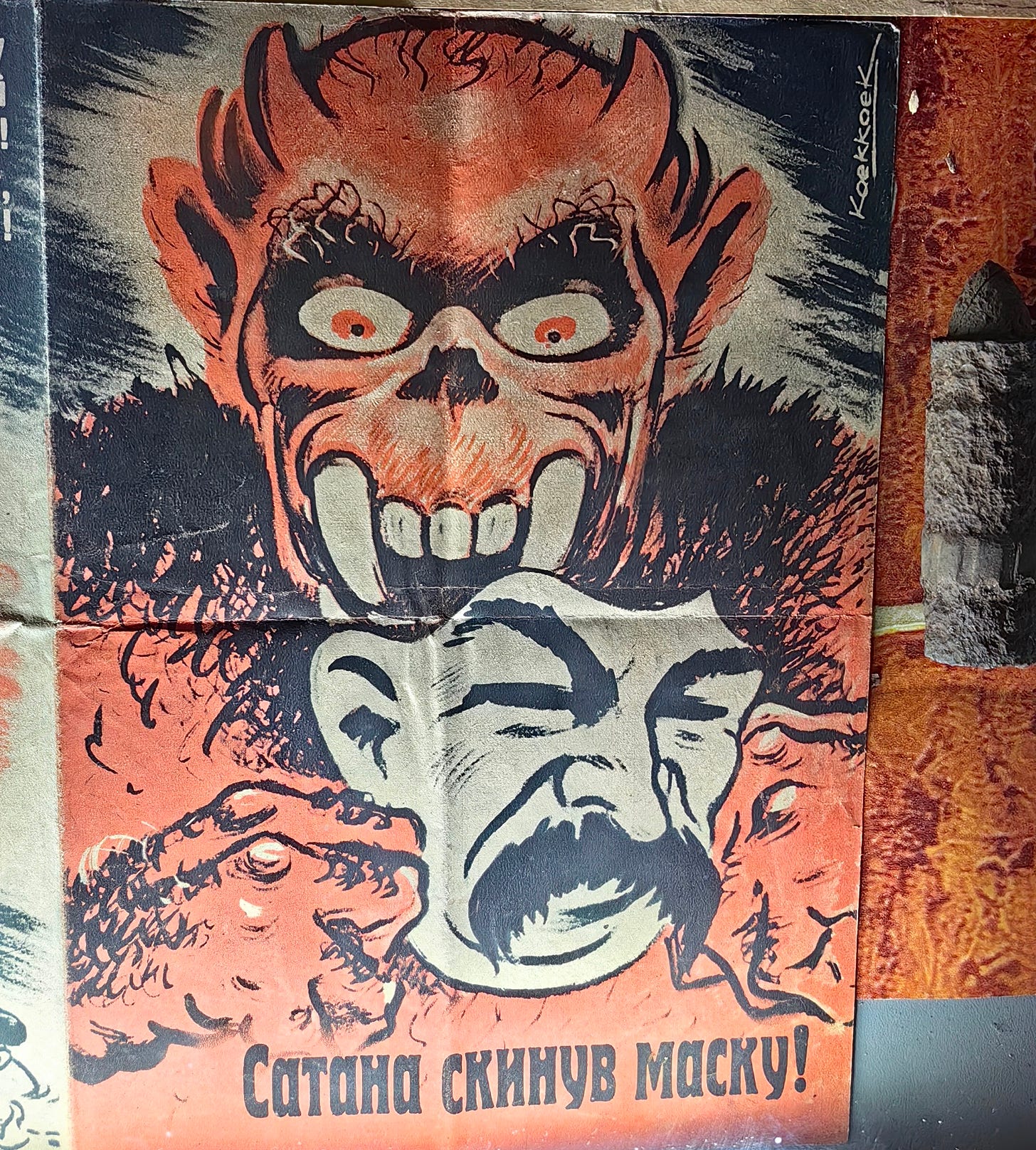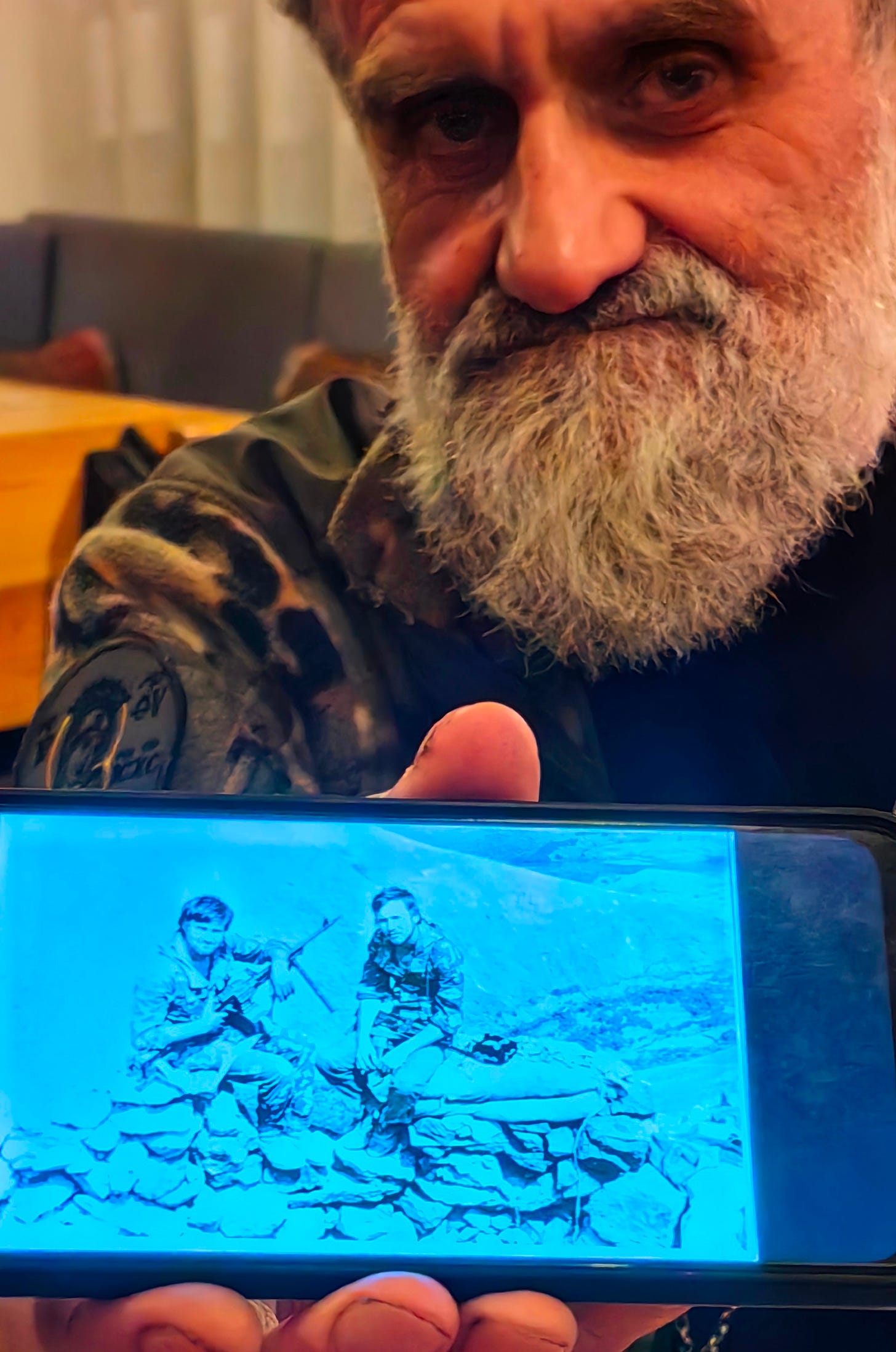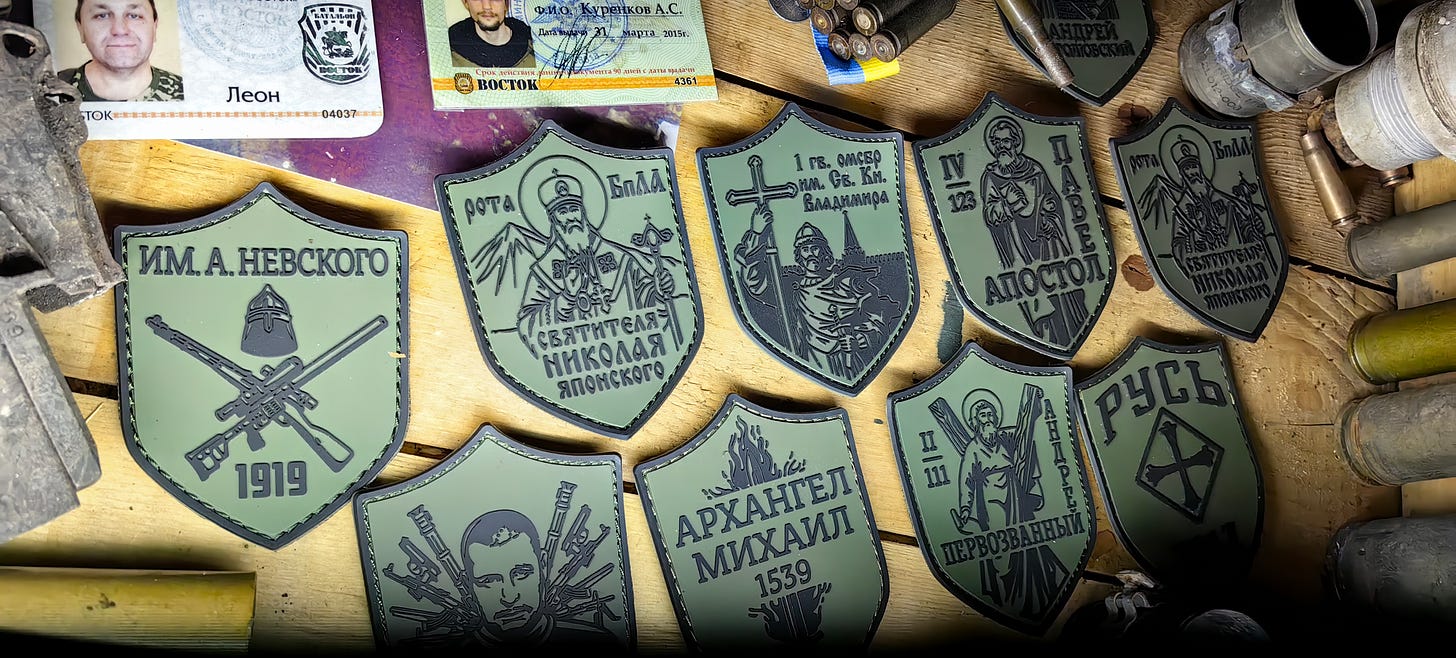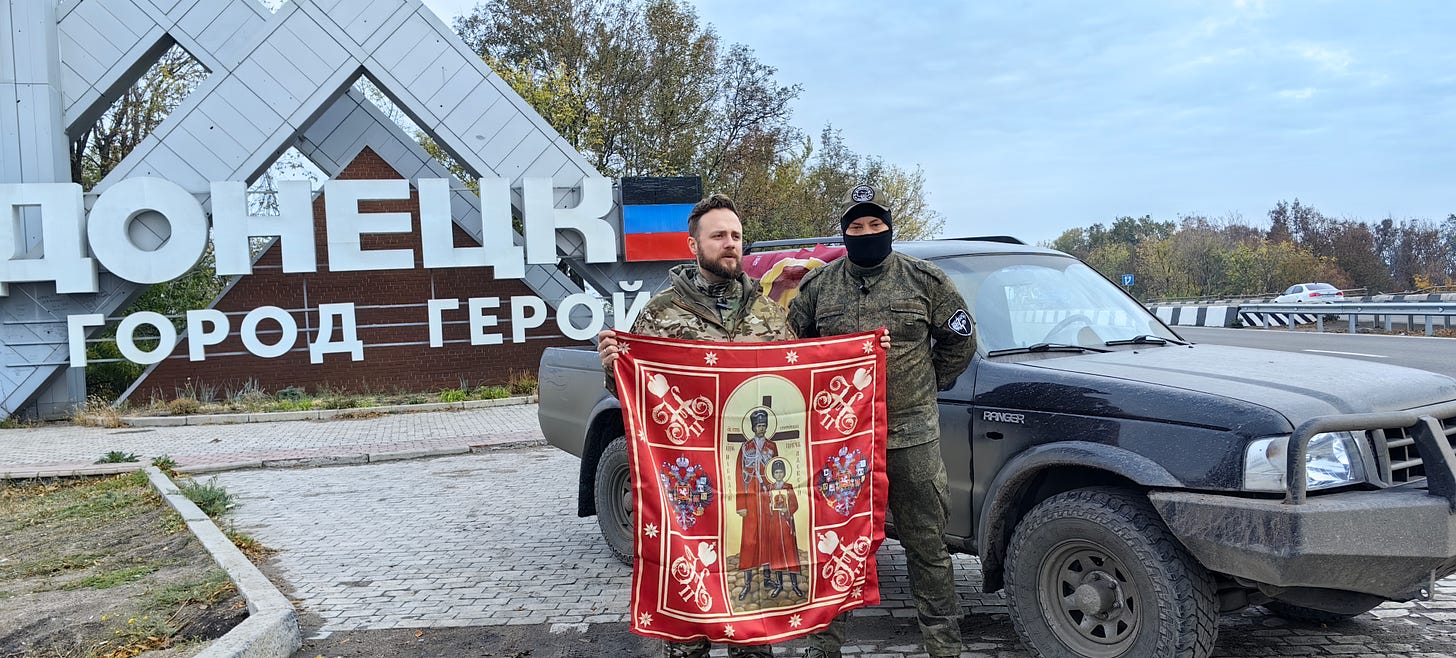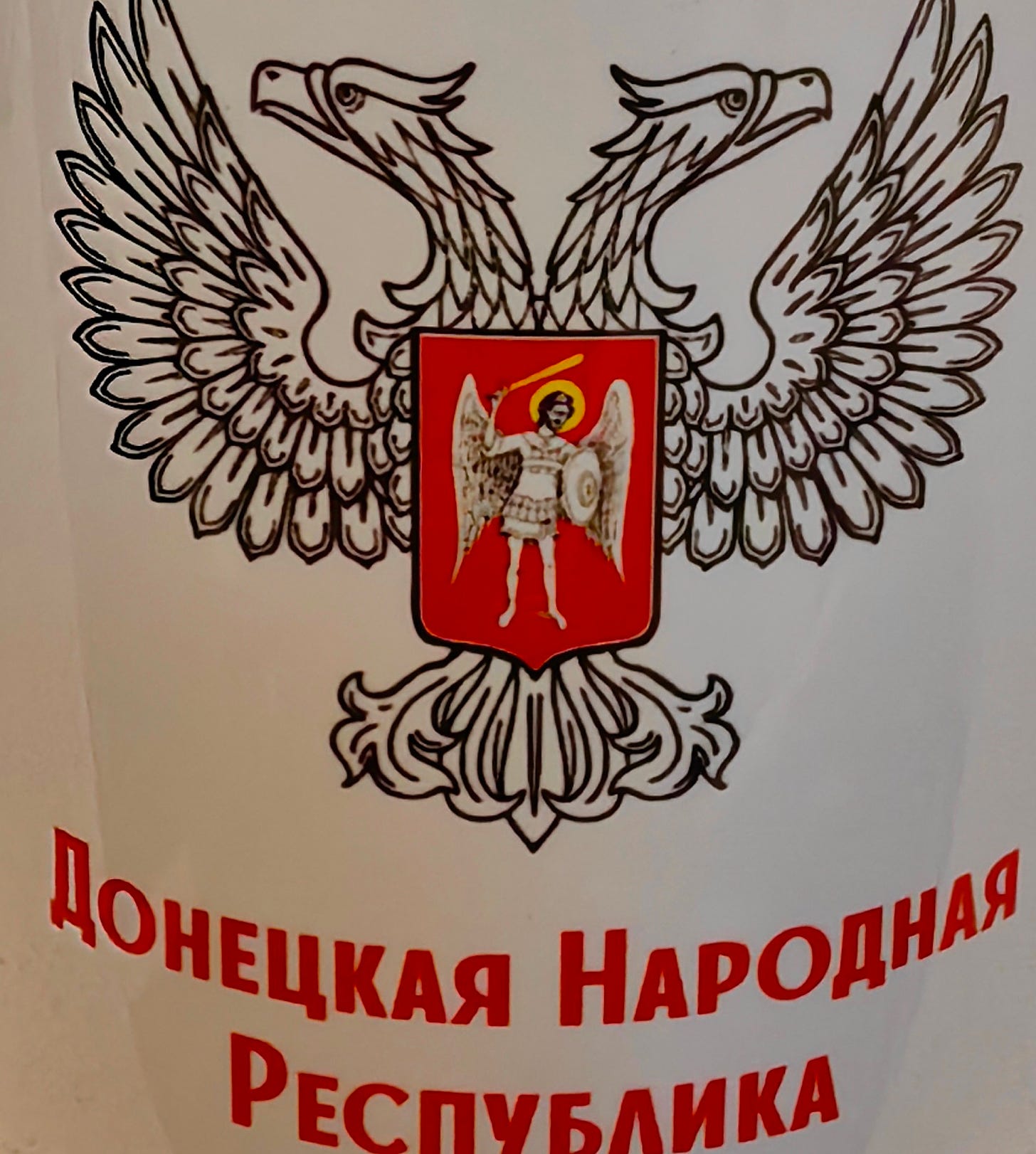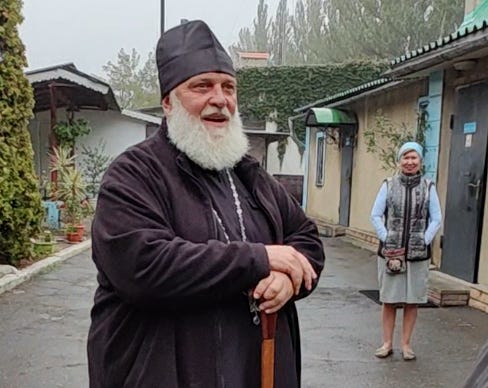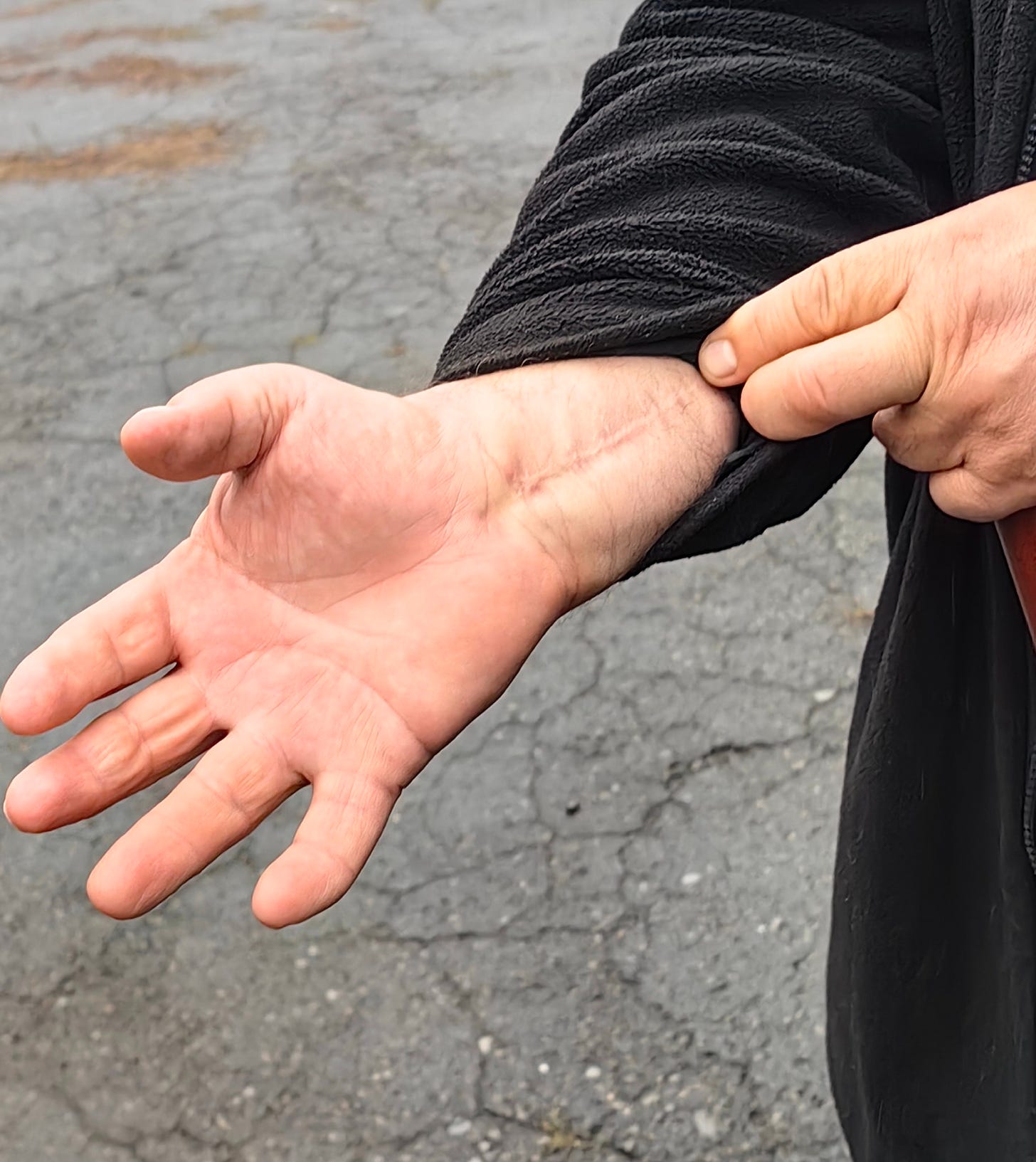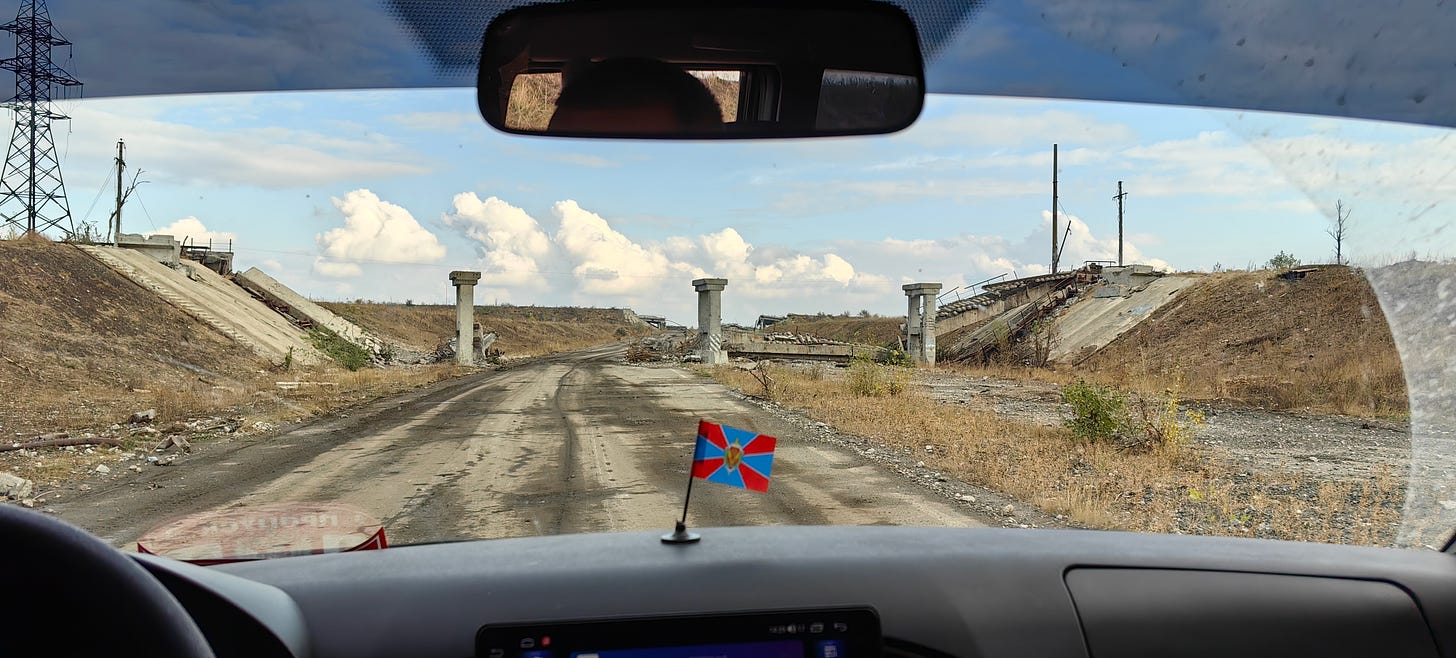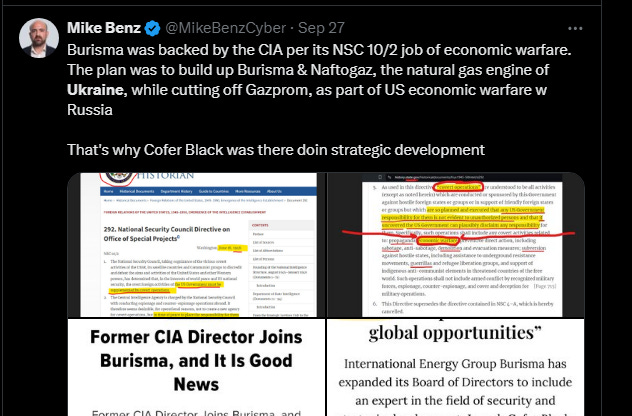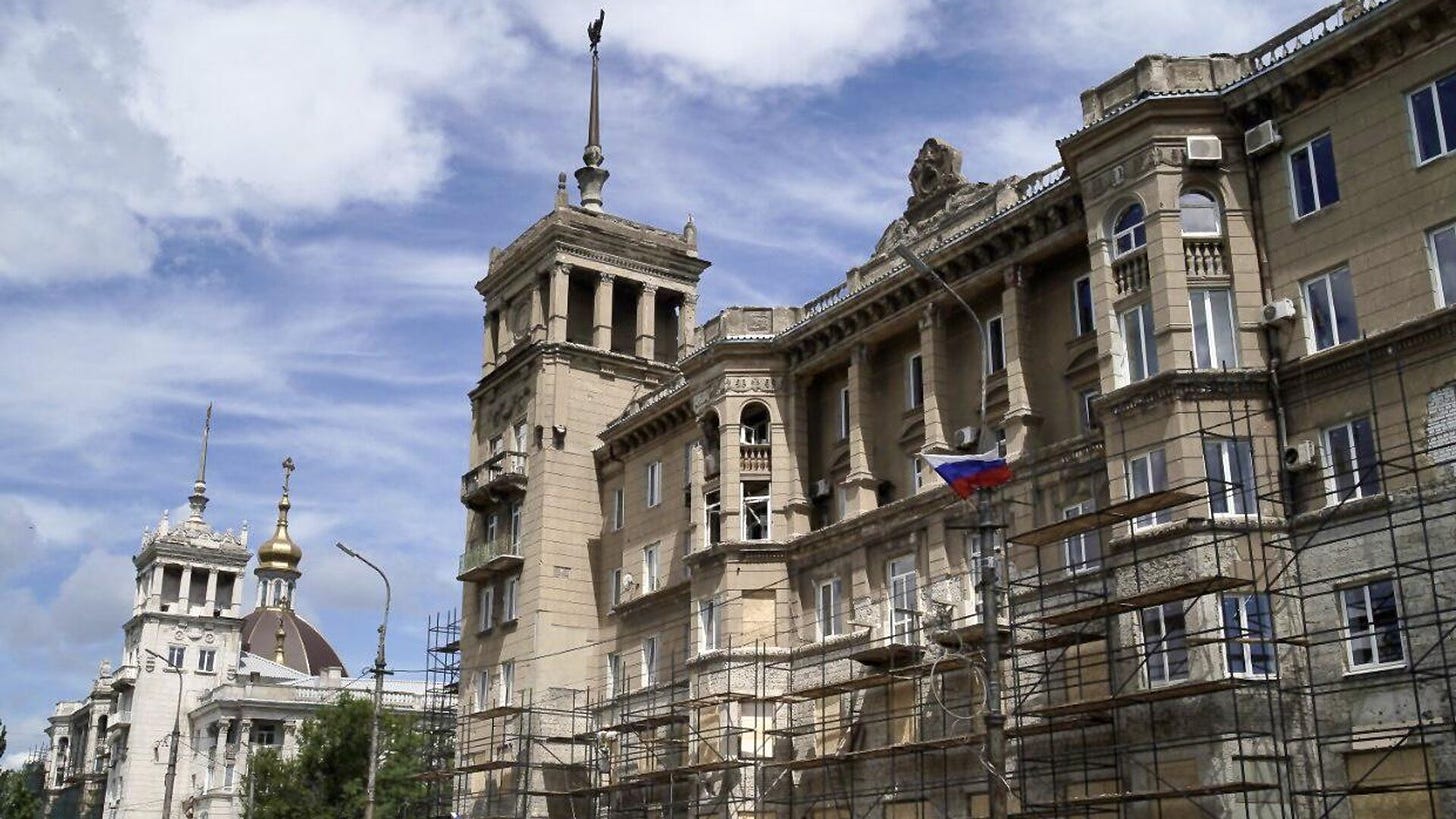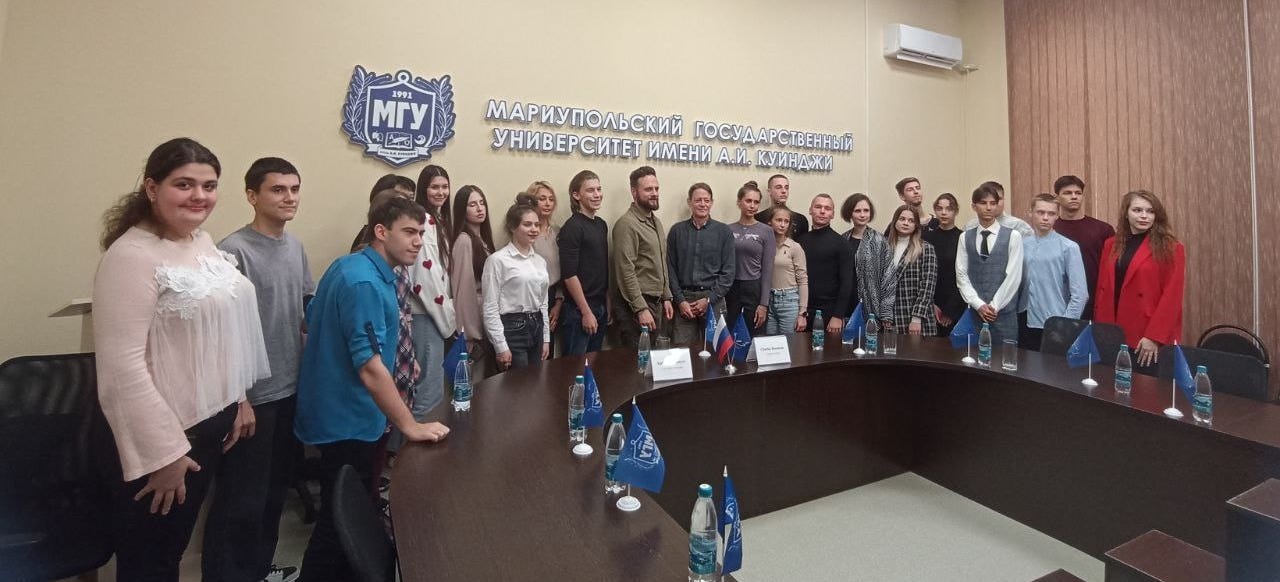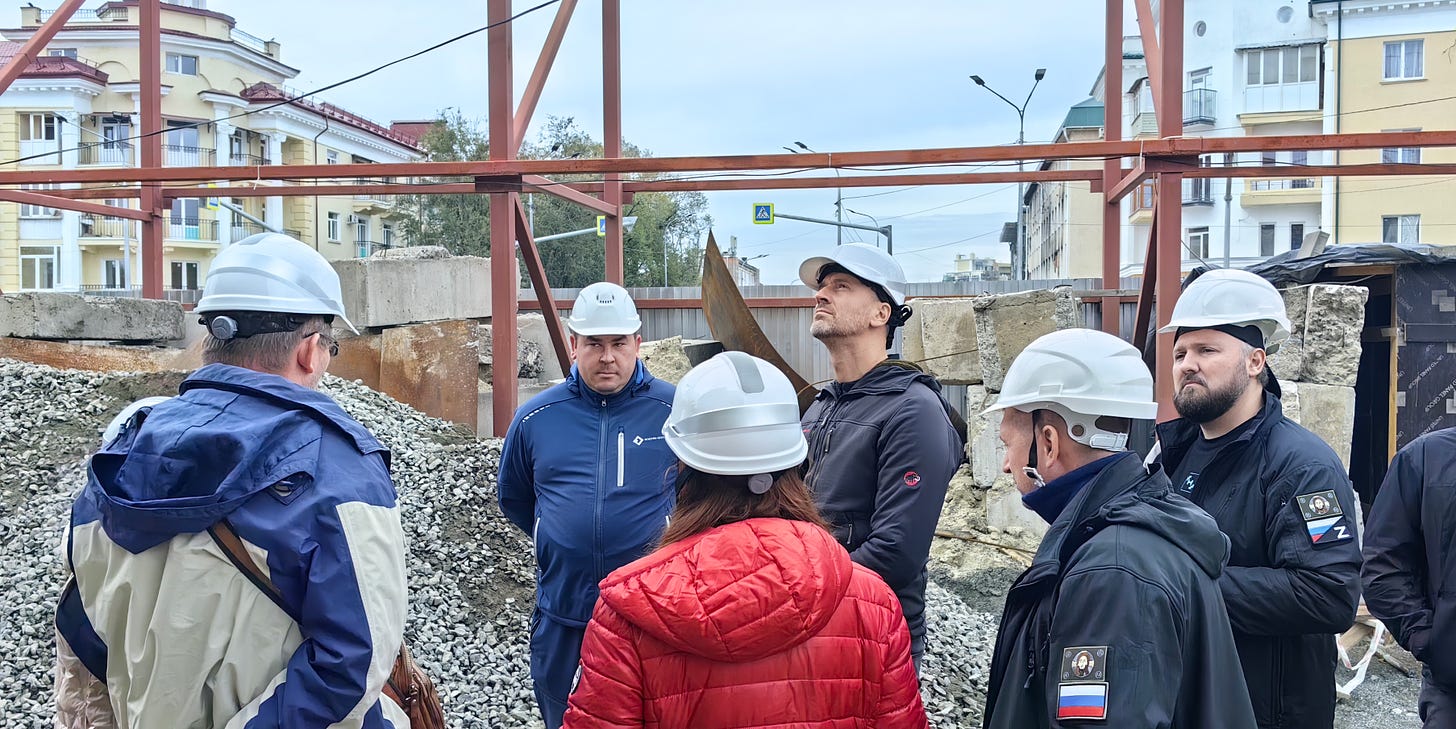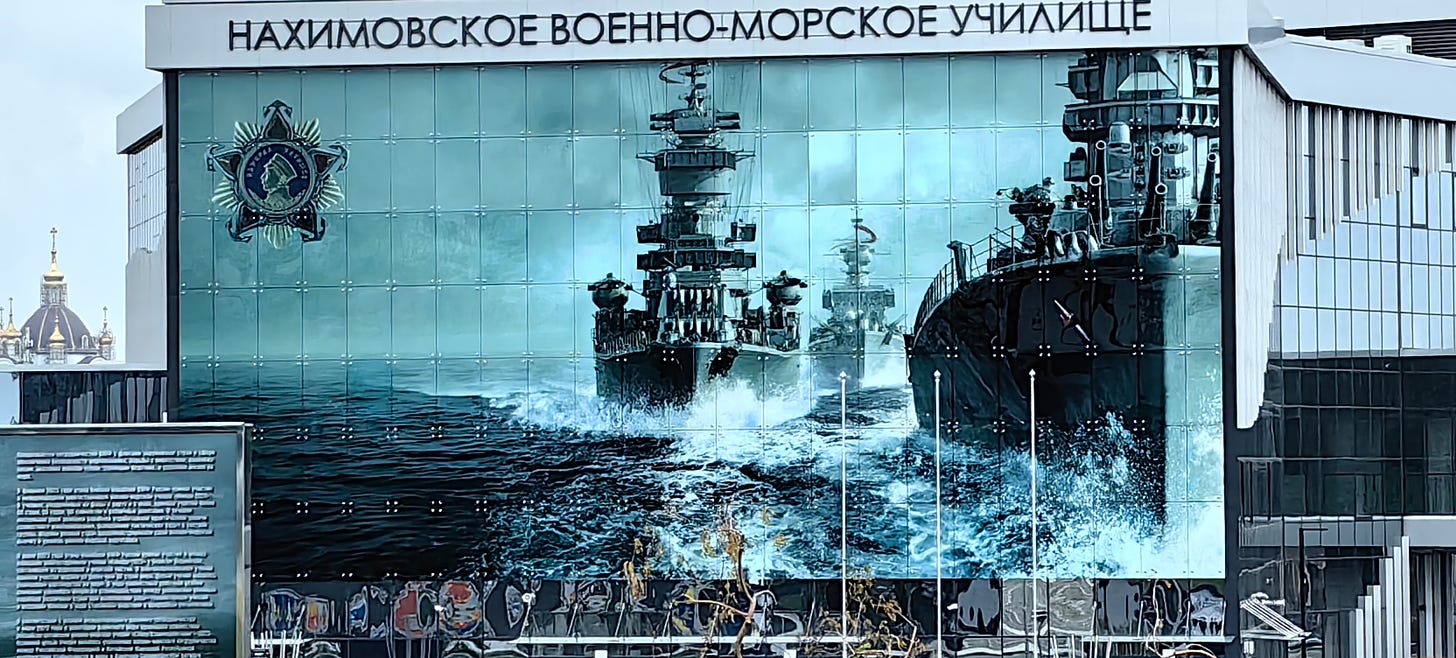What? you say? Isn’t it a war zone? Well, yes, but it looks like the war might end soon, and certainly with Russia keeping what it currently holds, and possibly a great deal more. However it comes out, this region will be very attractive for Westerners moving to Russia, a growing trend since Putin opened Russia to immigration from Europe and North America. This might sound counterintuitive, so let me explain. To understand why, one needs to know something about history of these lands, which are not ‘Ukrainian’, rather Russian, their correct historical name being ‘Novorossiya.’
The sky as we drove South through Lipetsk.
I recently returned from 4 days in the Donetsk Republic, and what I found was one of the most unexpected I’ve ever encountered in this enormous country, which is saying a lot. I went at the invitation the Donetsk government, whose goal it was to promote their side of the story regarding the war, and I was put on a jam-packed program focusing on this. Even for me who followed the conflict very closely from 2014 – 2018 or so, it was a big eye-opener. I don’t follow it as closely these days, and while curious about the latest developments, don’t write about it, because so many others do exhaustively. Before going, a Russian friend was explaining the history of this part of Russia going back a couple of centuries, and this is something I realized IS very relevant to future migration to Russia from the West, and I tried to gather as much info about that while there.
Entire villages flattened near Avdeevka. Not a single structure left standing.
Our program consisted of being shuttled around from morning till night to locations relevant to the war: buildings in the capital city of Donetsk completely obliterated by the odd rocket which landed in central, civilian areas, museums dedicated to the war, meetings with military priests, visits to churches damaged by shelling, to recent front lines where the destruction of former towns and villages was well-nigh complete, vast amounts of destroyed NATO equipment littered all over the place, very impressive new war memorials everywhere lionizing the heroes of her remarkable defense over the last 10 years and tear-inducing ones mourning the martyrdom of her women and children, and endless conversation with our hosts and their friends, themselves military men who have been there since it all started in 2014. We took a day-trip to Mariupol where we were shown the mind-boggling scale of urban reconstruction underway. I’ve been posting a lot of this Twitter, and will be posting more.
A German tank with US Maxpro infantry combat vehicles behind them. The logo of the manufacturer, “Rheinmetall” is visible on the front of the tank.
To me, the most important insight was how these 10 tough years have affected the psychology of the people who have remained, bringing out the best in people, purifying them, as it were, and crucially, strengthening their Orthodox faith. I was traveling with the Russian Christian TV Channel Spas, so we met many Christians, and I was struck by how many of them there were, especially in the military. But before I explain that, some history.
A US Maxpro infantry combat vehicle burned to a crisp.
First of all, some basics. You may have noticed that on this blog, and on Twitter, I put ‘Ukraine’ and ‘Ukrainians’ in quotation marks, and often just refer to them as Russians. I keep having to repeat this, because so many people on our side keep referring to ‘Ukrainians’, as if this describes a people or ethnicity. This is falling into the enemy’s little word tricks, and it misleads even the best people. So for the 100th time, there is not now, and never ever has been, a ‘Ukrainian’ people, ethnicity, language (real), literature, or national consciousness. This is vital to fully grasp what follows. They always have been, and are Russians, and have ever thought of themselves that way. I can write a whole article about this backed by facts, but for now, just trust me, this is the truth.
Very high quality memorials to the defenders of Donbass are very common.
The historically accurate and correct name for this part of Russia is ‘New Russia’, ‘Novorossiya’ in Russian. It was so-named in the 18th century when these regions were wrested from centuries of Islamic tyranny by Orthodox Christian generals from the Ottoman empire in the reign of Catherine the Great. They stretch much further West than what Russia has recently liberated from the clutches of the Gay American Empire (GAE), including Kharkov, Odessa, Kherson, and Kiev. All of this is historic Russia, much of it suffering for centuries under the Turks.
More memorials
I didn’t realize until after long rambling conversations with our hosts, sometimes bouncing over bombed out country landscapes, the degree to which the Donbass, a small region inbetween two big powers, Russia and NATO, ended up in a strategic position where their best option of many bad ones, was to simply endure years of war and abuse, toughing it out despite the grimness and grisly sacrifice, an eery foreshadowing of what The Resistance is enduring today in Gaza and Lebanon.
We encountered the banner of Christ, a Russian battle flag going back 900 years, everywhere. It is the most popular flag among Russian units.
Indeed, this visit cemented my impression that Donbass is part of The Resistance front in the Middle East. The genocide underway there is 100 times more grisly and awful, but the forces and funds perpetrating it are essentially the same. The behavior and tactics of the ‘Ukrainian’ military are very similar in spirit and complete absence of ethics, as is the relentless lying accompanying it in a massive bot driven media barrage. It’s almost as if the IDF advised and trained the Ukrainian military and propagandists, which I have no doubt they did, as NATO, the IDF, Western Intel agencies and Mossad have evolved into an interlocking criminal alliance.
Donbass also endured an assassination campaign against their military leaders very similar to Israel’s current one against Hezbollah and Hamas. I describe below the peculiar tough mentality of the people of Donbass below, and the history of how that emerged over centuries. This produced remarkable leaders during the intial 2014 uprising whose names and deeds have become legend – Givi, Mozgovoi, Motorola, Batman, Infant (Malysh), Batya, Zakharchenko, and more. One by one they were assassinated. At the time, Kiev’s very well prepared and funded propaganda forces very successfully sowed disinfo that this was all just infighting inbetween criminal warlords.
I asked our hosts about this and they scoffed at the idea. They allowed that it might be true about some of the less well-known ones, but that re the big names: Givi, Mozgovoi, Motorola, and Zakharchenko, it was clearly Kiev’s secret service. They further explained that these men knew that they could be taken out at any time because Kiev had 100 ways to get to them because of the ease of infiltrating agents into Donbass, for this is a civil war between Russians with no ethnic distinction between combatants. But they still stepped-up to lead despite understanding it was a likely death sentence. The strategy is pure Israel, along with other tactics such as using civilians as shields, indiscriminate shelling of women and children, deliberate targeting of churches, schools and hospitals, etc. – all tactics we see on horrific display in Gaza and Lebanon.
Alexander Zakharchenko, the first head of state of Donetsk, murdered by Kiev’s Mossad-inspired secret service.
Every loss has been turned into a memorial. Restaurant in central Donetsk which was booby-trapped, killing Zakharchenko.
To simplify recent history greatly, when the US foreign policy Blob engineered a color revolution, a euphemism for a coup, in Kiev in 2014, bringing in a rabidly anti-Russian government, the people of Donbass, like the Crimeans, said, no thanks, we’re out. Instead of being allowed to secede, they were attacked, and thus the war began. The Donbass was outgunned and outnumbered, their one advantages being 1) Fighting a defensive war from the bombed out husks of industrial infrastructure, and 2) the iron-clad will of tough men ready to die, recognized by Clausewitz as one of the key factors in war.
The Blob’s long game was always to draw Russia into a major war, something they partially achieved in 2022 by putting Russia in a position where its only logical move was to launch the so-called SMO, a risky move at the time which has turned out better than it might have. For the first 8 years of fighting, i.e. from 2014, Donbass had a powerful and strong friend to the East, but that friend could only help surreptiously, carefully limiting aid to what it considered would not provoke an escalation by NATO. There were stealth supplies of armaments, Russian military posing as volunteers, and real volunteers coming to Donbass’s aide, but it was barely enough to hold the line, with the fighting men of Donbass paying a terrible price. Casualties in war have propaganda value and are therefore kept secret and under or overstated. One of the many unsettling things about modern industrial war is that once the killing gets underway, observers are usually unsure about how bad it is, with realistic estimates usually pieced together by historians later. 13,000 civilian deaths, more wounded, massive infrastructure damage, collapse of the economy and complete disruption of civilian life are not in dispute.
Our hosts explained to us, and one can sense it in the very air, that this 10.5 year life and death struggle, still underway, has profoundly affected the mentality of the people, and this is relevant to what is likely to transpire once peace returns, and why I believe this region will greatly attract migrants from the West.
To understand this, one needs to understand who the people of Novorossiya were before the 2014 conflict, and where they came from. Novorossiya, much like the American West, was frontier country. Centuries of spoilage and pillage at the hands of the Turks had left this region depopulated, its hapless Slav villagers regularly raided and kidnapped – sold into the Ottoman slave markets. The edges of the Ottoman empire were basically controlled by marauding local warlords whose main economic model was piracy, pillage, plunder, and extortion. These bandits were an ethnic mix of mostly Turks and Mongols – the Crimean Tatars one of the better known subgroups.
A WW2 German Luger pistol in a war museum
WW2 German “Settler” or “Migrant” identity documents from a war museum.
The great Christian moral feat the Russian empire achieved in vanquishing these criminals is not well known in the West, nor are the implausible feats of her commanders, many of them exemplars of Christian piety, fighting under the banner of Christian Orthodoxy against Islam. Admiral Ushakov has been canonized and many faithful, including former Minister of Defense Shoigu, are calling for the canonization of General Suvorov, whose application of Christian faith to life and war is legendary. This white-out of Russian history is no accident. I keep saying in these articles how the lying about Russian history has been extravagant and going on for centuries. The Russo-Turkic wars of the 18th century are but one glaring example of many. Military buffs will love the mind-boggling history of Suvorov’s and Ushakov’s successes. It is no exageration to describe them as miraculous, one of the arguments for canonization.
A chart at a war museum showing the clear advantage Russia had in military equipment in 2023.
After this liberation, people began moving to Novorossia from central Russia. She attracted the brave and adventurous, the risk-takers, the big-dreamers, men with vision, ability, and toughness, men in search of freedom and opportunity, much like the American frontier. And not just from Russia, but from Europe too, primarily, as to the US in that age, Germans. Former Russian forts gradually grew into towns. Churches were built. Monasteries took root and grew. Like America, she fostered a hardy Christianity due to the conditions.
Like America, these empty lands were blessed with great natural wealth. The soil was unbelievably rich, the famed ‘Black Earth’ reaching to 2 yards of the world’s most fertile topsoil. The eastern regions were rich in coal, oil, and ore, spawning extraction industries driving the blazing industrial growth of Tsarist Russia in late 19th – early 20th c., again mirroring the American experience. Novorossiya has a long, temperate coast along the Sea of Azov, which feeds into the Black Sea, and from there, via Constantinople to the Mediterranean. The mighty Dneipr and its tributaries connect the region to northern hubs like Smolensk, and even the Baltic Sea. Ports and railroads grew. The region attracted entrepreneurs from Europe, again, mostly from Germany, who had the technical skills to build these industries. Many great fortunes were made. The region has an industrial town named New York, evidence of this immigration. Why it was so named has not survived, with various theories: one that it was named by an American entrepreneur, another that Germans named it after the north-western German city of Jork.
A 1921 poster reflecting the importance of Donbass to Russian industry of the time. It is titled “Donbass is the heart of Russia”
Despite all this activity, few major cities emerged in what is today the Donbass. Instead a network of industrial settlements spread, built around mines, factories, railroad hubs and ports. The region became an investment priority for the Soviets, who built the industrial powerhouses of Donetsk and Mariupol and their ginormous steel plants and mines, the scenes of so many recent fierce battles, and imported Russians from European Russia to work them, creating large cities, Donetsk with a pre-2014 population of 1 million and Mariupol with 0.5 million. The ‘historic’ centers are marked by Stalinist Classical style, big columns, some ornamentation, and somewhat human scale, before the inhuman architectural disasters visited on Russia in the 60s – 80s. In 4 days I counted only a handful of buildings predating the revolution.
The government seat of the Donetsk People’s Republic, and example of the atrocious inhuman Soviet architecture of the 70s and 80s.
Donetsk residents have marched around the Donetsk government building every day since 2014 carrying icons and crosses to protect it from shelling. It was never hit, despite its massive size.
Poster on door of the above building: “We won in 1943, we’ll win this time too!”
Interesting side note: Novorossiya has substantial Greek ethnic heritage. I wasn’t able to acertain current numbers, but many Greeks fled there in the 18th c. from Crimea, where they had flourished for centuries during and after Byzantine rule, fleeing genocide at the hands of the Turks / Tatars. Mariupol and Melitopol are Greek names, with more dotting the Azov coast. They became the strongest of Russian patriots, remembering who gave them shelter from that catastrophe, and sharing an Orthodox faith. In 2014, historically Greek Donbass towns were among the most active in running ‘Ukrainian’ ‘nationalists’ out, standing with Russia.
A Greek town as we approached Mariupol.
Even the pre-WW2 years of Soviet industrialization attracted the adventurous. The Soviets couldn’t achieve everything through force and intimidation. While savaging Novorossiya’s prosperous farms with famines and murder, they granted industrial workers in the cities privileges, encouraging them to move there. This included less persecution of the church, perhaps because they figured that religion was not a strong threat among an ideologized, proletarian working class.
Devotionals and icons carried by Kiev troops.
The Soviets invested heavily not just in industry, but also cultural and social life, with top-notch theaters, classical orchestras, ballet, sports teams and stadiums. The Stalinist downtowns of Donetsk and Mariupol, while completely Soviet, have an unexpected charm and grace to them, with ubiquitous well-planned parks and boulevards of tall graceful white Aspens with thick white, birch-like trunks.
The main Theater in Donetsk, a great source of pride and always sold out, a typical example of Stalinist classical architecture.
Donetsk is a mining town, and Mariupol a steel town. The above history, combined with the Soviet industrial legacy, molded a very different psychological type than in central Russia. It reminded me of the Pittsburgh steel worker stereotype, with a more mediterranean, less gothic feel to the cities. The people are very stoic and proud of their country and its industrial might, tough as one can imagine, physically large and strong. Entering Mariupol from Donetsk, a giant steelworker statue greets you at the city limits, epitomizing the type – musclebound, placidly resolute, rooted to the ground.
A chat with a veteran of the political upheavals of 2014 gave an insight into the type. He recounted events of those days: one day there was a pro-Kiev demonstration on the central city square, which this giant with bear-sized hands and his comrades came to observe. The pro-Kiev crowd, filled with the astro-turfed ‘neo-nazis’, invented, much like ISIS, by American and Israeli intelligence (these two are practically indistinguishable), started shouting anti-Russian slogans, demanding repression of Russian culture and language. This burly fellow then matter-of-factly explained: “so we beat them up”, as if it was just a routine kind of thing, like taking out the trash or swatting away a fly, not causing much strain, and really the only polite and decent thing to do.
A very small part of a display from a war museum of shrapnel and parts of shells they claim were retrieved from civilian targets.
More from the display.
Another insight came from a local describing the working conditions in the Donbass mines. Because they are old, some of them going back to the 19th c., they are very deep, roughly a kilometer, or about half a mile. Their depths are scorchingly hot due to proximity to the earth’s magma core, so workers strip to their underwear, and even mostly naked, can only work a few hours before being completely exhausted. It’s like doing hard physical labor in a very hot sauna. And it is dangerous. Imagine the personality type forged in a lifetime of those mines, blast furnaces, and smelters. The HBO miniseries about Chernobyl portrayed this type of Soviet mine worker very well if you saw that one. Even the party bureaucrats were scared of them. Not people you want to get into street brawl with, much less a war. They will likely be very good at building their country and economy when the war ends.
Now add the pychological conditioning of the last 10 years. One veteran put it like this: “All the bad people left.” “What do you mean by ‘bad’?, and what percentage of the population left?” He guessed roughtly 40% of the pre-2014 population. Perhaps 30% of that to ‘Ukraine’ for various reasons, the rest to Russia. Then he ennumerated: the cowards, the money-grubbers, the physically weak, the liars, the unpatriotic, the careerists, the criminals, the lovers of softness and luxury, the materialists. The ones who stayed then went through a kind of crucible, whether on the front or at home, for a society at war shares in the burden, the grief, and the emotions of those who suffer most. He went on to say that everyone knows who left, their personal circumstances, and why, and that this will be remembered long after the war ends.
We traveled with a $1000 Russian-made drone detector. It only went off once, when we were in Avdeevka.
One evening about 8.30 pm I set out from my hotel in central Donetsk in search of a bite to eat, and to my surprise discovered that all shops and cafes are required to close by 8pm. What’s more, a military curfew has been in place since 2014 – everyone has to be off the streets by 11pm. These measures help in combatting Kiev’s provacateurs, so easy to infiltrate into the Donbass. Our hosts told us that people have just gotten used to it, with a whole generation of children growing up never having seen a bustling evening urban scene. One result is that going to be early, and getting up early, has become the norm, a healthy outcome in my opinion as Russians are notorious night owls.
A soldier took us for a spin in a brand new Russian BMP-2, infantry combat vehicle. It was very bumpy but moved surprisingly fast.
Very few societies endure war for long. Gaza is the longest I can think of, lasting decades, but Donbass’s 10 years is certainly in the upper reaches, and not typical. Most last weeks or months, the rare one more than a year. When a proper spiritual guidance is available, as in Donbass from the Orthodox Church, it brings men closer to God, and has a purifying effect, making people stronger, more noble, less selfish, more sacrificing, better able to understand what is important and what isn’t.
Of all the remarkable things I encountered in Donbass, this was by far the most compelling. Her people have become even more different than in Russia, comparatively soft from a regular peaceful existence. Since the start of the SMO it has been surreal to live in Moscow. After the first few months of excitement, one realized that life seemed hardly affected, and as months stretched into years, I often felt guilty when days had gone by and I hadn’t even thought about the men, Russians on both sides caught in a bloody civil war, dying or being horribly maimed everyday.
Before 2014 Donetsk was quite prosperous, featuring several modern hotels. This one asks visitors not to enter with firearms.
In Donbass, the energy, whether civilian or military, is palpable and infectious, a shared tension, sacrifice, urgency, adrenalin, and danger. Russia only recently succeeded in moving the front beyond artillery range of Donetsk city, so it was quite common for a shell to land in populated areas, quite deliberately. With the front further away now, the hits are rare, but occassionally a drone or guided rocket gets through.
One thing I never understood going back to 2014 is why civilians stayed in Donetsk when it is not safe. I asked everyone I could, and finally got a somewhat rational, but not entirely convincing explanation: it’s due to the length of the war. Going to refugee shelters or relatives in Russia seems like a sensible option for a few months, or up to a year, but after that people are faced with the reality of completely uprooting their life, getting jobs in far away places, finding a place to live, rebuilding their lives anew, and abandoning friends and relatives who carry on. Faced with this, they often choose the risk of returning and staying, where they have their main material asset, their home, and friends and relations.
German WW2 anti-Soviet propaganda aimed at ‘Ukrainians’ from a war museum. “Satan drops his mask.”
Amazingly, schools are full of children and life goes on. One evening we visited one on the edge of town closest to the front and one could hear the steady rumble of artillery – missile defense batteries at work, like distant thunder. The shelling wasn’t close enough to be dangerous, but it was an ominous reminder of how near the war is. Some of the windows in the school were cracked and taped over, the odd one had shell or bullet holes. It seemed implausible that anyone would send their children there, but they do. Ultimately the explanations were not really rationally convincing, and I had to put it up to stubbornness and patriotism. I often heard the refrain: “This is OUR land, and we will NOT abandon it.”
This trial has, not surprisingly, made the population more Christian. Many frontline troops are turning to Christ, and the same has occurred among civilians. I met 3 wonderful priests there, each one a larger than life personality, and all great talkers, full of good humor and spiritual wisdom. They told me 20,000 troops have been baptized on the front. Russia’s total forces involved in the SMO are around 1 million, but the number at the front, where the military chaplains are active, is much lower, around 300,000. There is a serious movement among units to adopt names of Russian saints, with hundreds of units doing so. Underground trench churches are also common.
A banner with insignia of Russian units named after Orthodox saints.
Father Vitaly, after a lifetime of military service including active duty in many hot spots shows us a picture of him in Afghanistan. Actual soldiers make the best military chaplains.
More Christian insignia
Visiting with one of the units named after St. Nicholas II (+1918), the last Tsar of Russia.
The Donetsk coat of arms from my coffee mug features the Tsarist double-headed eagle and St. George the Dragonslayer.
One of these priests was the epitome of the Donbass personality, as if from central casting. 65 year old Fr. Victor, another giant, with huge wrists and hands, a thick flowing white mane, barrell chest, ruddy cheeks and lips, booming bass voice, warm and charismatic, a sort of over-sized Santa Claus. He is pastor to a Donetsk neighborhood closer to the front, and refused to leave, despite clear danger. He, at least, had a rational excuse for staying – “How could I leave my flock?”, he countered. Well, why do THEY stay? And the long explanations began. Then he sang a magnificent church hymn, his powerful bass rattling the window panes, it seemed.
Fr. Victor the fearless.
Eventually shrapnel did catch Fr. Victor, badly wounding him in the legs and hand. Patched up, he returned to his church, and says he will never leave. Icons, paintings, and photographs of St. Tsar Nicholas II, the last Tsar of Russia, and his family, all now saints, are the most common in Fr. Victor’s little church, but he had hurried off before I got around to asking him why they seemed to be favorites. I came away from the encounter thinking to myself that these people are unconquerable.
Singing a hymn.
Fr. Victor showing one of his several shrapnel wounds.
Inside Fr. Victor’s cozy church.
One reason why this is so is because they are not entirely rational, and therefore unpredictable. Bismarck, who got to understand Russia well serving as Prussian ambassador in St. Petersburg for several years where he learned Russian, famously quipped:
“Never get into a fight with Russians. They’ll counter every strategem with unpredictable stupidity.”
He had many more good aphorisms and stories about Russia.
This old and recent history is key to understanding the opportunities which await Westerners in Donbass, and indeed, all of liberated Novorossiya, when the war ends. The region has been depopulated and will urgently need newcomers. The temperate climate and sea shore are certainly an attraction. But more compelling are the extraordinary economic opportunities.
Destroyed highways outside Avdeevka. These overpasses were all taken out, I counted 4 of them in a row. One can see the next one in the distance. And a lot of potholes – everything must be rebuilt.
Despite being mined for over a century, East Novorossiya sits on an $US11 million trove of energy, mineral, and metal deposits. The best description I’ve seen of this is from Mike Benz (Twitter), who has explained in detail how the Larry Finks of this world (what an apt name!), were salivating over it. Hunter Biden and Burisma were no coincidence. The vultures were circling, and Benz argues that a major motivation for NATO pressing for a war in Novorossiya was to push Russia back so as to exploit her riches.
In addition, towns need to be rebuilt and small businesses created. The economic boom in Mariupol gives a sense of what Donetsk can expect. Because it is further from the front, a confident Moscow has embarked on a massive renovation and rebuilding program there, having built or repaired some 2000 buildings and restarted local industry and agriculture and food processing, creating many jobs in the decimated economy. The brand new buildings are impressive indeed, and the repaired ones look much nicer than the originals. The town looks better and more modern than before the war. Highways and roads almost unnavigable a few months ago due to damage from shelling and tanks tearing them up, are now new and smooth. I’ll write about this in a separate article because the implications are large.
The region’s seashore has large tourist potential for the beach-loving Russian people. And then there is the famous black earth, offering enormous opportunities in agriculture. Regarding the latter, landmines are a serious problem, and no one could give me an answer about how long they would be an obstacle to farming. Mines are everywhere, and one is cautioned against even walking on the grass in central Donetsk, let alone the fields outside the city.
Downtown Mariupol
Russian social services like pensions and medical insurance are functioning in both Donetsk and Mariupol. Mariupol university has been renovated and looks brand new. 1000s of teachers have been trained and are returning to schoolrooms. Internet is steady and reliable. Regular water supply has returned. In Mariupol, life seems quite normal. In Donetsk the famous theater and symphony are booked out. Understandably, this is hugely popular with the locals, for under Kiev’s inept system of oligarchic plunder, little was invested in social infrastructure and services benefiting the people.
Russia is clearly playing for the hearts and minds of the people. In contrast with Kiev’s chauvinist approach trying to de-Russianize everything, persecuting churches and clergy and discouraging the historical language, Russia is going to great lengths to do the opposite, encouraging anyone to use the so-called ‘Ukrainian’ language if they so choose, and making it available in schools. I have a feeling its popularity will not last long.
Construction everywhere in Mariupol.
Events are moving very quickly at the front with Kiev falling back ever faster. Trump’s likely victory suggests the war could end soon. Our hosts in Donetsk pointed out that Trump’s hand will be very weak, and with the war going so well for Russia recently, any peace will be dictated by Russia. The one card Trump holds is ending sanctions, but these have turned out to be rather ineffective, and so of little value. The mood in Donetsk, understandable considering what they have endured, is to insist on maximum territory, including Kiev and Odessa and a complete replacement of the government of rump ‘Ukraine’ with a neutral disarmed one – essentially total capitulation.
Some argue that Russia will trade more land in ‘Ukraine’, for giving the GAE a freer hand in the Middle East. Others think this is unlikely, as Russia can take as much of Ukraine as they want anyway, and ceding influence in the Middle East could be a catastrophic long term error. However it turns out, the addition of a lot more territory to Russia, and the attendant economic opportunities for Western immigrants, seem very likely at this point.
The new naval academy on the shore of the Azov sea. Russia is serious about dominance in this region.
A facade of the academy.
So Novorossiya will be, just as it was in the past, a place for the ambitious, the adventurous, the builders and dreamers. It needs, and will attract, talent from the US and Europe. Perhaps the most valuable thing they will find there is not material fortune, but the personal qualities in those who stayed, a society purified by the tragedy of war, with a more powerful Christian faith, wiser and stronger than it was before.


